Turquoise Energy News Report #182
Covering July
2023 (Posted August 11th 2023)
Lawnhill BC Canada - by Craig Carmichael
[CraigXC at Post dot com]
www.TurquoiseEnergy.com
= www.ElectricCaik.com
= www.ElectricHubcap.com
Month In "Brief"
(Project Summaries etc.)
- Several Possible Materials for Improved Peltier Modules? -
Magnetic Variable Torque Converter
- Lithium Ion Battery Explosions - Cabin Walls: Cellulose Fiber
Insulation & Heating Energy
In
Passing
(Miscellaneous topics, editorial comments & opinionated rants)
- Unqualified Legislatures - Hair Gone, Back Tomorrow? -
Scattered
Thots (Tinnitus, les Geurres) - ESD
- Detailed
Project Reports
-
Electric
Transport - Electric Hubcap Motor Systems
* Magnetic Variable Torque Converter
Other "Green"
& Electric Equipment Projects
* Oxy-hydrogen ("HHO") Gas: A Better Way? - with Reducing Flame
* July Gardening
Electricity Storage:
Batteries [no report]
Lithium Ion Battery Resurrection from the Dead?
Electricity Generation
* My Solar Power System: - New Grid Tie Inverters, New Wiring
- & The Usual Latest Daily/Monthly
Solar Production log et cetera - Monthly/Annual Summaries,
Estimates, Notes
July in Brief
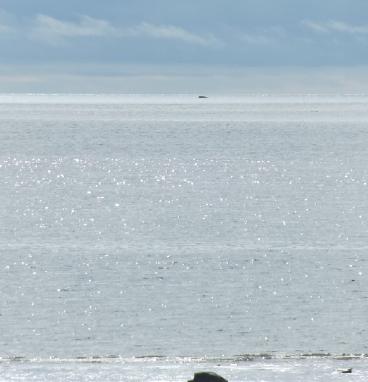 Way, way out in the water, at the
lowest tides
a rock sticks up.
Way, way out in the water, at the
lowest tides
a rock sticks up.
The sand bar from Sandspit caries on north under the waves
just off the coast for several kilometers, and apparently there
are rocks in it, with this one especially big one. To miss this bar
and these rocks, boats and ships take what looks like a crazy
approach to Haida Gwaii, edging down just off the coast and then
veering back out to sea before turning in and entering Skidegate
channel. Previous ferries with deeper draft had to wait for the
tide to rise before they could even enter this hidden maze.
For a bit I got into that headspace where, no matter what
I was
doing or that it took all day, I started feeling guilty about all the
other things I want to do or should get done that were inevitably
being neglected. It'll be something of a miracle if I *ever* finish all
the presently conceived "green energy" & electric transport
projects, let alone any exciting new ones that inevitably seem to come
into view in my travels.
Between the energy projects and other things like food
gardening, making the cabin and other improvements around the acreage,
and as I get older, I don't seem to have a lot of spare time in which I
also have the energy to do active things. I greatly improved if
not cured my long-bad upper back and strengthened my shoulders by going
for walks wherein I actually leaned backwards, swinging my arms as I
went.
With that and the rototiller I could do a lot more garden prep and in
May I gave myself "tennis elbow" somewhere in the exertions of
preparing the garden beds. Since then I've set it back at least a
couple of times by doing too much heavy stuff and it hasn't yet healed.
That has been slowing down my cabin build, to the point where I may not
get that last wall done this year after all.
Several Possible Materials for
Improved
Peltier Modules?
I thought I would leave Peltier improvements behind last
month, but then I wondered if there were other simple ceramics that
might be
better than alumina and also in pottery supply catalogs. I looked up a
table of thermal conductivities on Wikipedia. Here's a short table:
Electricly insulating
Material
|
Thermal Conductivity
W/(m*°C)
|
Alumina (The usual mat-
erial for Peltier modules)
|
30
|
Beryllia
|
209 - 330
|
Aluminium Nitride
|
70 - 210 (ceramic)
321 ("single crystal")
|
Boron nitride
("graphite" structured)
("diamond" structured)
|
30 or 600, depending
on orientation
740
|
Silicon nitride
|
90, 177
|
I didn't find much more in oxides, and beryllia wasn't in
a pottery supply catalog I checked, but a few nitride
materials had very high heat transfer properties. Some were said to
form stable ceramics. They weren't in the catalog either. Making a
ceramic with nitride instead of oxide
I'm sure would require special processes. Boron nitride sounded tricky
to work with: the "diamond" form would surely be hard (impossible?) to
make as a
wafer, and in the graphite form heat transfer across the grain is poor.
Aluminium Nitride ceramic, especially if it can be produced with
conductivities in the mid to upper end of the range listed, could be
much better than the oxide. But even the lowest figure is more than
twice as good. Silicon nitride's figure depended on the source. But it
sounded promising and even 90 is three times better than alumina. Boron
arsenide had a theoretical value of 1400, even higher than diamond
(~1000), but in one trial achieved
"only" 190. It sounded pretty exotic and I didn't check it out very
far. Between nitrogen and arsenic in periodic table column 5A (valence
-3) is
phosphorus, but I didn't see any figures for phosphide ceramics, if
indeed they can be produced.
Beryllia may still be the simplest and best choice. Can it
really be that none of the Peltier module makers have investigated it?
I guess that's the difference between R & D and "business". In
general business just ramps up production of whatever has already been
tried and found to work. The idea that what they're making today may be
superseded by something better tomorrow scares and threatens business
instead of exciting them. I still can't understand why peltier module
makers aren't investigating these materials, when Peltier performance
is so marginal with alumina. The first company to make Peltiers using
beryllia should sell millions of them since they will perform better,
even if they are twice the cost.
I
contacted an "advanced ceramic materials" company which had beryllia
"heatsinks" that looked in a photo like peltier module covers, but they
said they had "no idea" about using them for that. I thought it was a
salesman who hadn't passed me on to the technical or R & D
department. I persisted with a second email, but he said they buy the
beryllia parts and really don't know much about them.
Now I've found what appears to be "the" supplier of
beryllium oxide, materion.com. They mine and process beryllium. One o'
them big global outfits. Let's see what their ceramics division have to
say. If it sounds feasible maybe I'll get 50 grams after all and see
what I can do with it if I sinter some thin plates for a module. Or
maybe they make little plates themselves I could buy. OTOH if they tell
me there
actually is some source of commercial peltier modules made with BeO
instead of Al2O3, I'll just get the contact info instead and buy a
couple.
Making a peltier module looks like a job more intricate
than I'd care to tackle (and I can't find the thermocouples at
electronic component suppliers), but my peltier refrigeration story
might not be over yet!
Magnetic Variable Transmission/Truck
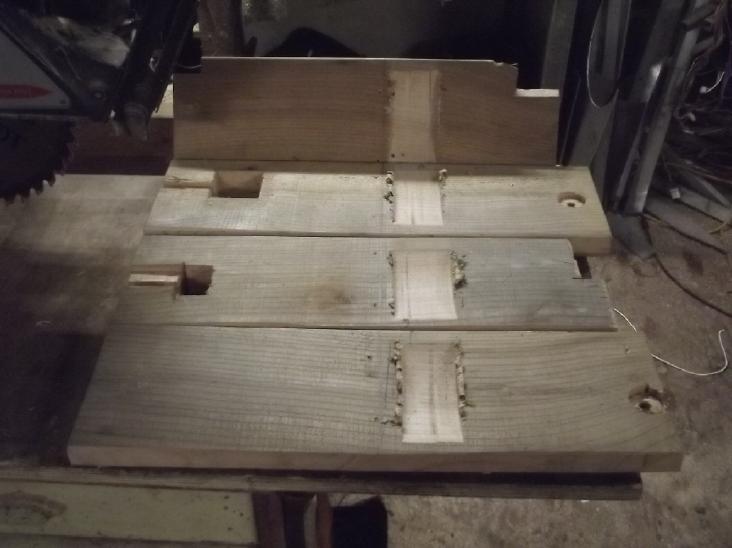 I got just a
few little things done. The new rotor being a bit bigger diameter, I
had to cut some grooves in the housing boards so it would fit in.
I got just a
few little things done. The new rotor being a bit bigger diameter, I
had to cut some grooves in the housing boards so it would fit in.
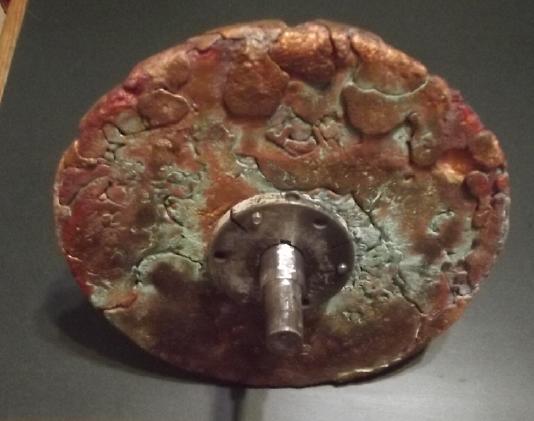 With some
fiddling around, filing and grinding, I did make the cast copper rotor
essentially fit, put the assembly on
the truck and turned it on. The truck moved at motor "idle" speed on
flat concrete,
but the messy cast copper rotor was so out of balance that I didn't
dare press very hard on the pedal owing to the intense vibrations. I
certainly wasn't going to try going anywhere. I suppose this was fully
predictable. I'll have to balance it by attaching weights before I try
again.
With some
fiddling around, filing and grinding, I did make the cast copper rotor
essentially fit, put the assembly on
the truck and turned it on. The truck moved at motor "idle" speed on
flat concrete,
but the messy cast copper rotor was so out of balance that I didn't
dare press very hard on the pedal owing to the intense vibrations. I
certainly wasn't going to try going anywhere. I suppose this was fully
predictable. I'll have to balance it by attaching weights before I try
again.
I'm interested to try making an HHO torch/furnace with a
reducing flame for melting copper without oxidizing it, since the
casting went so poorly with the electric furnace, except for the first
pour. For that I need to make a hydrolyzer that separates the H2 and O2
gasses so a little oxygen can be bled off. (More under Other
Projects)
Lithium Ion/Lithium Polymer Battery Explosions
Li-ion & polymer batteries look more and more unsafe
in the long term. There was that airplane that went down a while back.
Lately I keep seeing titles for videos saying electric cars burning up
is more common than we realize, and how they burn so fast and so hot
that often people don't make it out of the car. Then in late July a car
carrying ship with around 500 EVs and other vehicles on it was gutted,
apparently when an EV burst into flames. With tied-down cars packed
like sardines it was impossible to put out and it quickly spread and
engulfed the vessel. The crew had to jump overboard and one person was
killed. It was said that another ship had burned
previously from the same apparent cause. And on August 1st I saw a
report that someone's house was written off from smoke damage when a
loaner EV car lit up in their garage.
With my solar power I have been charging my lithium-ion
cells to only 3.95 volts (~90-95% charge) instead of to 4.2 volts, to
be more
gentle on them. But I can't control the charging of the 2015 Nissan
Leaf. (The 2013-2015 model is said to have a great environmental
control in the battery box and so mine should have no problems. Great!
Hmm... how far can I park it from the house and the charger cord still
reaches?) So far it has proven to be a great car and I haven't heard of
a Leaf catching fire.
I am more and more inclined to the BYD philosophy that I
heard at a BYD event in Victoria BC in 2017: lithium iron phosphate
batteries are a little heavier, especially if they are also made to
last longer, but they are safer. BYD was making their own lithium iron
phosphate cells for their electric trucks, buses and cars.
Then there's a 1,100,000$ hydrogen powered bus that blew
up while being refueled. Apparently it's not the first such explosion,
and considering how few hydrogen powered vehicles there are on the
roads, that must make for really bad percent-wise safety
statistics! AFAIKT
the prime reason for hydrogen powered vehicles is so those "rentiers"
who have been selling gasoline can sell us something else instead as
future prospects for petroleum dwindle. Electricity available anywhere
and perhaps made for free with solar panels just "doesn't fit their
business model".
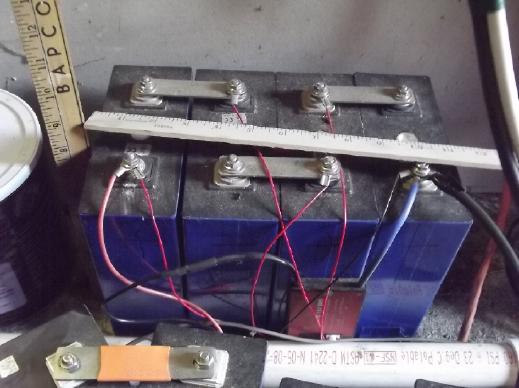 This set of 3.2V, ~300AH (12V,
3600 watt-hours)
lithium-iron phosphate cells
This set of 3.2V, ~300AH (12V,
3600 watt-hours)
lithium-iron phosphate cells
(on my garage floor) weighs about 50 pounds. The ten lithium ion
cells in
the Sprint car are 36V, 120AH (4320 watt-hours) and only weigh 42
pounds.
I'm becoming inclined to think the safety factor is worth the 43% extra
weight.
Cabin Walls: Cellulose Fiber Insulation & Heating Energy
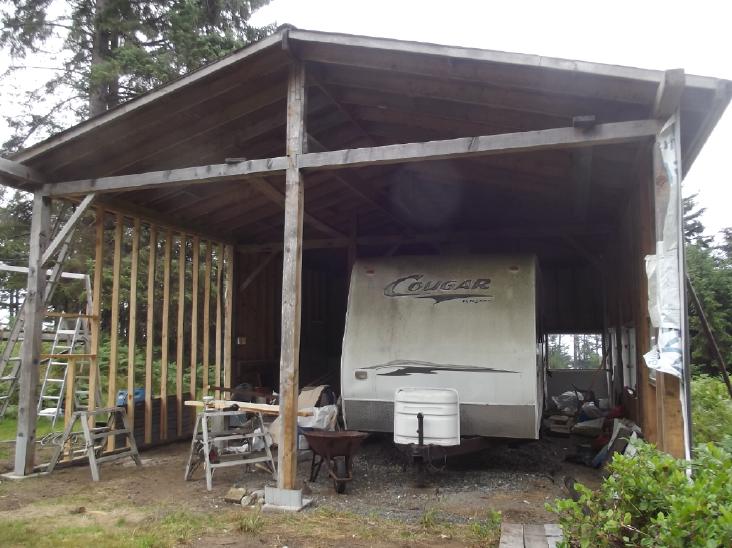 I was getting
various things done around the acreage over
July, and one of them was I decided not to use lawn grass to insulate
the cabin walls. Instead I'll use commercial cellulose fiber. Grass
worked out to about R3 and cellulose is R4, which is 33% better
insulation. And cellulose fiber is a well known, fire retardant
material which will surely
break down in the environment. Fiberglass is itchy and "never" breaks
down. To fluff up the compacted cellulose in the bags, I plan to use
something like a paint stirrer on
an electric drill at a good speed, starting by dumping clumps of the
material into a garbage can - or maybe some pail with a good spout.
Then I'll just pour it down the walls by leaving a strip at the top
without gyproc until it's filled... and the same thing for the roof. I
plan to sheet in the rafters the same as the walls, rather than have an
attic space.
I was getting
various things done around the acreage over
July, and one of them was I decided not to use lawn grass to insulate
the cabin walls. Instead I'll use commercial cellulose fiber. Grass
worked out to about R3 and cellulose is R4, which is 33% better
insulation. And cellulose fiber is a well known, fire retardant
material which will surely
break down in the environment. Fiberglass is itchy and "never" breaks
down. To fluff up the compacted cellulose in the bags, I plan to use
something like a paint stirrer on
an electric drill at a good speed, starting by dumping clumps of the
material into a garbage can - or maybe some pail with a good spout.
Then I'll just pour it down the walls by leaving a strip at the top
without gyproc until it's filled... and the same thing for the roof. I
plan to sheet in the rafters the same as the walls, rather than have an
attic space.
In my old house in Victoria, there were some wall stud
spaces that were open at the top, and I just fluffed up 'Cellufiber'
from
the bags with my hands and let it fall into the wall. I stopped when
it reached the top (a 20 foot tall column), and in the many years I had
the house after that, it never shrank down into the wall space at all.
So I'm not big on the supposed need for "power filling" walls to double
density with a machine "to prevent settling". My rough count is
fifty-five 25 pound bags instead of 83 or more. (It'll probably be
somewhere well over 1000$ delivered to here, but that's a lot less than
any other type of insulation.) And I expect that similar to what I
found
when experimenting with grass as insulation [TE News #___], there's
little more insulation value in packing
the cellulose material more densely. (unlike with fiberglass batts,
which are better if pressed in.)
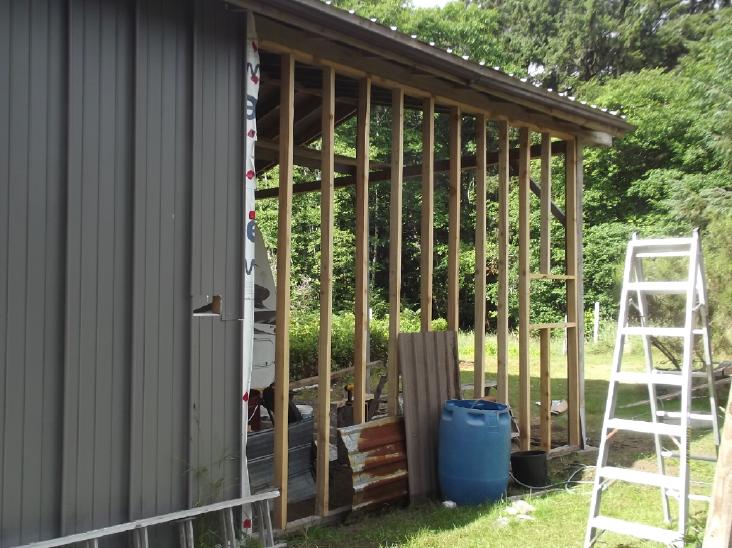 One might
wonder why I made mostly 2 by 4 walls
instead of
the presently more common 2 by 6 standards. Well, the ways we heat
(& cool)
homes are energy hogs, and presently energy is costly. But I see the
value of such thick walls as a temporary situation, not
long term. What do I expect will change?
One might
wonder why I made mostly 2 by 4 walls
instead of
the presently more common 2 by 6 standards. Well, the ways we heat
(& cool)
homes are energy hogs, and presently energy is costly. But I see the
value of such thick walls as a temporary situation, not
long term. What do I expect will change?
First, if I ever get the open
loop air heat pumping with outdoor "heat recovery" working with
something like the hoped for COP of 10, that's 1000 watts of heat for
each 100 watts of electricity put in. [TE News issues from about
January & into spring 2020] It need hardly be said that the energy
needed to heat or cool a home this way would be rather minimal.
Second, solar power is getting cheap compared to other
sources of electricity. If that can be combined with cheap batteries,
power usage will become less and less a concern.
And third, now that the
energetic HE ray band 10 octaves beyond the gamma ray band seems to be
becoming at
least vaguely known to science and appears to penetrate Earth's
atmosphere, how long can it be before we have almost free energy
originating [mainly] from the Milky Way? People have occasionally been
harvesting energy presumably from this source since Nicola Tesla seems
to have done it 100 years ago,
and better documented, T.H. Moray in the 1930s, and various others much
more
recently. The coming decades will surely see its adoption and the
diminution of fossil fuel use for all purposes, and perhaps the gradual
elimination of electric grid long distance power distribution networks.
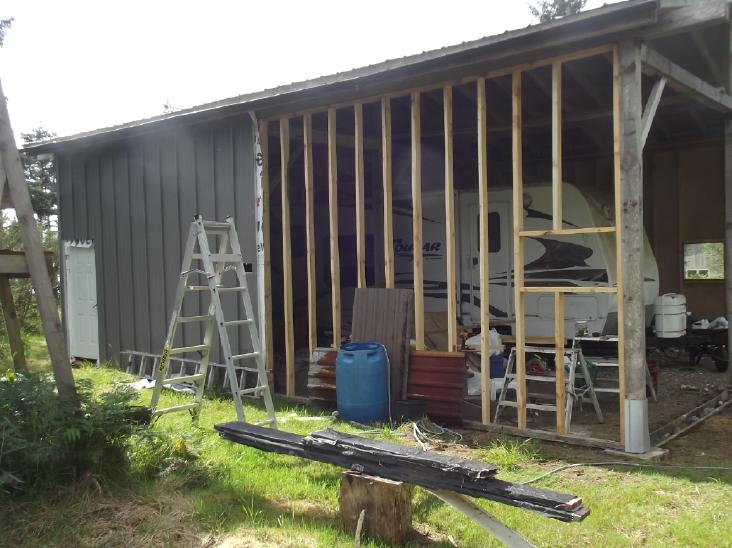 By the end of
the month I finally had the next wall section framed. The trench and
form
was done for casting the next concrete footing on August 2nd (in doing
which I hurt my elbow again) and the travel trailer was out on the 3rd
or 4th. For the first time the interior is clear and I can work on all
parts of it.
By the end of
the month I finally had the next wall section framed. The trench and
form
was done for casting the next concrete footing on August 2nd (in doing
which I hurt my elbow again) and the travel trailer was out on the 3rd
or 4th. For the first time the interior is clear and I can work on all
parts of it.
I hope to wall it in entirely this year - three wall
sections. Compared to the work pace so far, that's an ambitious goal.
It seems my best months to work on it are mid July through mid
September - gardening pace slows, days are still long and the weather
is generally conducive. Even then it's a "part time" endeavor. The rest
of each year seems to be a "write-off" as far as building the cabin
goes. But once the walls are up, the more finished it is, the easier it
should be to heat and work on in any weather. There's plenty more to do!
In
Passing
(Miscellaneous topics, editorial comments & opinionated rants)
Unqualified
Legislatures
A legislature was originally envisioned as being a cross
section of the society that elects it. This has not worked out owing to
the way we elect the members. A cross section of society would have
laborers, scientists, chemists, businessmen, farmers, doctors,
teachers, homemakers and so on. Instead we have more or less uniform
bodies of "politicians" who mostly have no qualifications except
ability to convince people they are with the right "party" which should
be elected. Lawyers, used car salesmen and more lately corrupt
"puppets" willing to work for unelected behind the scenes donors are
common talents of legislators.
Thus, when an issue comes up, laws are often passed
seemingly "off
the cuff" by a body of people none of whom are more than superficially
familiar with the subject and who fail to first study likely (or even
obvious) unintended consequences. Their edicts are then taken to be the
wisdom of society and enforced to the enth degree.
One of a
zillion mountains
of plastic cluttering landfills and blowing around through the
environment throughout the world
 I have a case
in mind. In 1969 as single-use plastics were just starting to come into
widespread use, a petroleum institute study concluded that there was no
way to get rid of waste plastics other than to incinerate - burn -
them. Since then thousands of times as much plastic has accumulated in
the environment everywhere throughout the world. Plastic recycling is
virtually a scam, recycling up to just 9% of all the plastics consumers
conscientiously separate into the recycling bins. And probably more
petroleum product is burned as fuel in trucks carting it around than is
actually contained in the plastic!
I have a case
in mind. In 1969 as single-use plastics were just starting to come into
widespread use, a petroleum institute study concluded that there was no
way to get rid of waste plastics other than to incinerate - burn -
them. Since then thousands of times as much plastic has accumulated in
the environment everywhere throughout the world. Plastic recycling is
virtually a scam, recycling up to just 9% of all the plastics consumers
conscientiously separate into the recycling bins. And probably more
petroleum product is burned as fuel in trucks carting it around than is
actually contained in the plastic!
Plastic waste is
probably the world's biggest environmental problem today. I just have
to walk across my "pristine" acreage next to the wilderness, or along
the beach, to spot and pick up various broken up bits of it as I go.
When I bought my house in Victoria in 1977 plastic shopping bags were
just coming into use. By the time I sold it in 2017, there wasn't a
square foot of the yard anywhere where one wouldn't find some little
bit or bits of
plastic in the grass, in spite of much picking it up. Once burned,
plastic will never clutter land and sea or be swallowed by sea life,
many whole species of which seem to be dying off from it. (If I
can't always tell plastic from seaweed without very close examination,
how are sea turtles and birds going to do so?)
Now, I understand, the BC legislature has banned
burning
of ALL
plastics! This seems utterly contrary to reason. There are
certainly some nasty
plastics used in household items that give off toxic smoke when burned.
But a high percentage of single use plastics burn more cleanly than
gasoline. They are just solidified petroleum, hydrocarbons. They
liquify with heat, then gassify and burn just like any other petroleum
product. Logic would dictate then that burning of diesel, gasoline and
paraffin wax candles should be outlawed at the same time. I put this to
my own MLA
by email and got no response, much less a justification or rationale of
why this law was created. Did she vote for it? How do I hold her
responsible if she did?
Of plastics that are impractical to recycle, surely half
can be burned with less environmental effect than driving a car, saving
countless acres of plastic dump space and ensuring it never clutters
the broader environment.
I submit that the BC legislature probably had no experts
of its own, never heard of the Petroleum Institute study or studied the
whole problem
itself, and consulted with those employed by the "recycling" business
if anyone at all. Did they visit the huge plastic mountain on the lower
mainland? If none of the members had studied
the subjects involved, studied the chemistry or knew the vast problem
needing solution or the
options, then they were not qualified even to work in this
subject
area,
much less to pass laws restricting the options of those who do.
A legislature elected differently would have had experts
in various fields of science, chemistry, and some who knew in at least
some detail what was happening in waste disposal and "recycling" and
available options, to provide knowledgeable input and sensible
proposals. These would have been elected by their peers - by others
working in and hence at least nominally knowledgeable about similar
subject areas, not by the general public. (More on plastic below.)
How would one elect a legislature that truly is a cross
section of society? We would abandon land-based representation. The
place one lives is only of minimal consequence in the makeup of a body
that passes laws affecting the whole of the province/state or nation.
Instead, we would elect by areas of interest, training, experience and
knowledge. The people voting would know those who are running by
professional or social reputation and so the elected would be much more
directly responsible to the electorate - one essential prerequisite for
effective democracy. In England until more recent times parliament had
representatives elected from Cambridge & Oxford universities in
addition to all the land area based representatives. This gave what
perhaps seemed like unfair special representation to academia, but it
also provided members in the legislature with special expertise instead
of uniformity. It was a mistake to eliminate them. The concept should
have been expanded instead, to be made fair to all.
Here are a few "off the cuff" suggestions:
* Labor and trades representatives elected by laborers and trades
workers.
* Family reps elected by those who choose to register in "family"
category(s).
* Basic Education representation elected by teachers and other
educational workers.
* Academia, Higher Education reps, elected by those with scientific and
technological skills.
* Health Professional reps elected by health care workers.
* Legal Representation elected by lawyers, barristers and so on.
* Industrial reps. by those directing or working in industry.
* Natural Resource worker reps.
* Arts, Music reps
* Creative Designers, Inventors reps.
(These are not intended to be a comprehensive or well
thought out list with no conflicts or omissions, just suggestions for
initial thought.) Specialist members of the legislature should
replace unelected lobbyists. Decisions for society should be made in
the legislature by knowledgeable people, not behind closed doors and
rubber-stamped by a house of elected but ignorant representatives with
no qualifications in the area in which legislation is proposed. If an
industry wants influence, it should hope to elect a specialist in the
field who can put the case and propose sensible legislation well.
Everyone gets to register in a voting category. People
change and grow, so registration may be changed periodicly, perhaps at
census times. And perhaps there might be two or even three sets of
voting categories, with everyone registering in one category in both
(all three) sets, and hence being empowered to pick people who
represent him in two (three) different ways?
In Canada and many other lands we have the additional and
serious problem that two of the three branches of government are
combined into "parliament". As any high school political textbook can
tell us, we can never have smoothly functioning governing procedures
and systems until the executive branch is separated from the
legislative. You need to have a separately elected leader who can take
timely actions when they are required without first referring to a
legislative body for deliberation and who, in taking action, does not
interfere with legislative deliberations. That's another topic!
"It's not that one general is better than another general,
it's that one general is better than two generals." - Winston S.
Churchill
A Bit On Plastics: Disposal, Recycling
There are many greatly
different types of plastics.
Polyethylene H-(C2H4)-(C2H4)-(C2H4)-...n-H
accounts
for 34% of all
plastic production and is the most common of all single use plastics.
It burns cleaner than most anything else, with the combustion products
of H2O and CO2. Except for minor additives such
as coloring there are no other elements in it besides C and H. Wrap a
plastic bag around a stick (or a coat hanger wire?) and light it on
fire. It liquifies then gassifies and the gas catches fire. Just like
gasoline it is vaporized gas that burns. Only cleaner. Burning gobs of
it drip off and sizzle as they fall to the ground, burning there until
none is left. There is no smoke. There is no residue. except from the
stick.
The ban on burning polyethylene adds 51% to the total of
the "we don't know what to do with it" plastic waste stream.
Someone was tossing huge sheets of polyethylene in a bin
at the refuse station. I said to the refuse guys who were there that
they should have him dump it on the accumulating half-burned wood and
use it as kindling/fuel to get the wood better burned. "You're trying
to get me in trouble!" said one. Is it going to be shipped at great
expense and burning of more petroleum than was in the plastic to BC's
great plastic mountain down south? Or just to the landfill here to
gradually disintegrate and blow through everywhere and into the ocean?
Ditto for polypropylene (polypropene) - polymerized
cyclopropane. H-[CH3-CH-CH2]-...n-H.
As a single use plastic for containers and bits, it also burns cleanly.
Wikipedia says that only 1% of PP is recycled.
DIY/Small Scale Plastic Recycling: "Recycling 2.0"
My own "Plastic Recycling 2.0" with simple box molds and
weights, melted in an oven, can be much more practical than other
recycling methods. Even things like beach ropes with grains of sand in
them can easily be remelted into useful forms like tiles, plates and
bars.
Molding PE/HDPE/UHMW into such new forms with these
techniques, I found while doing a small object that it doesn't seem to
have an odor when melted in a kitchen oven indoors at about 400°F
(205°C).
Polypropylene ropes OTOH seem to off-gas as they melt and
have a strong objectionable smell. For PP the oven should be outdoors.
PP needs about the same oven temperature as PE.
See Plastic Recycling 2.0, TE News #164 to #178 (TE
News
Index; search within index page text for issues with
"Recycling 2.0" in their contents.)
Hair
Gone,
Back
Tomorrow?
I read an article where some guy, bald for decades, fell asleep in
his chair, slumped forward and fell into his fireplace. His scalp was
badly burned. After that, his hair regrew. But why should the doctors
be "mystified"?
To me it seems like a sure bet that he would have started
using alcohol or other antiseptic on his scarred scalp to prevent
infection. That killed the Demodex Folliculorum mites that
"everybody" gets in their hair follicles, more and more as they get
older. What mystifies me is
why these mites, closely related to the Demodex mites that cause
fur loss
("mange") in dogs, cats, sheep and so on, and which feed in the hair
follicles on the sebum that nourishes hair growth, are not understood
by medicine as being the plain and obvious cause of thinning hair and
baldness in humans. In a search I didn't find a single hair loss study
that even contains the word "mite" or "mites", so it would seem the
relationship has never even been studied.
But a question I have had has been answered: If one gets
rid of the mites, will hair regrow, even from baldness? Apparently it
does, or at least might. My own hair is thicker than just before I
started a once weekly
rub on my scalp with ethyl rubbing alcohol. Until then I was sure I was
headed for baldness. I never paid any attention
before it was badly thinning but three years later I don't think it's
"100%" thick again, and since I wasn't 'bald for decades' I figure I'm
not a good test case concerning the potential for regrowth from 'none'.
Since my hair hasn't come back 100% on top, I'm just now
going to twice a week treatment to see if that helps. I'm also thinning
the alcohol to 50% so it's not so harsh on the scalp, and so I can
dispense with taking a shower right afterward. With a squirt bottle I
spray the mix around over my head and some onto a hair brush, then I
brush to work it into my scalp.
I note that its makers don't know how "Rogaine" works. I
don't think it's their "magic ingredient" at all. It contains alcohol.
They recommend dabbing or spraying it daily on the thinning spot. I
figure that since the alcohol only kills the mites of the thin patch,
they move in pretty quickly from all sides. Still, after two weeks
without treatment the little "scabbies" start coming back, and I figure
twice a week is probably not too much.
Note again: Vodka (40% alcohol) is said to work too. Full
strength rubbing
alcohol is too harsh on the scalp. I wouldn't try isopropyl alcohol.
Scattered
Thots
* Tinnitus Remedies This
month I decided to try putting an "envelope" of 2 inch mesh chicken
wire on my bed. A wire grounds it to an electrical outlet ground. I put
a thick towel over the bottom mesh and my pillow inside, and get my
head inside it when I go to bed. It's not a comfortable piece, but it
helps with the tinnitus. Sometimes by morning instead of a piercing
tone, especially on the left side, it is reduced to a somewhat quieter
"white noise" of similar high pitch. And it becomes more variable. I
sometimes notice it getting louder with each heartbeat or rather,
softer in between beats, or "warbling" in pitch and intensity. And I
hear other lower pitch, low volume tones that I used to hear that have
long been drowned out by the high, piercing one.
I also made two "helmets" to cover my whole head except my
face, one of tinfoil and one of a stiffer alume large rectangular pizza
tray. I can clip a ground wire to either one with an alligator clip
test lead when I'm sitting at the computer. These too seem to be
helpful, but I think they really need to cover the face too, with some
transparent conductive visor. (The "tinfoil hat wearing conspiracy
theorists" have it wrong. It has to cover the whole head!) But they've
proven impractical to wear most of the time. Even sitting at the
computer it's a nuisance. So as the day goes on, the tinnitus seems to
get louder again until bedtime.
I'm sure the whole front end of my property is much too
close the 14,400 volt power line on the poles out front. I'd estimate
that one would want to spend most of one's time at least, say, 200 feet
away from them. That's a hard distance for many including me to get to.
And of course power lines run along a line; they are not simply a point
source whose field strength varies inversely with the square of the
distance.
And then there's all the 120/240 AC volts so close by in
all the walls of the house.
My cabin has metal roofing, alume exterior wall covering
and steel doors. I'm putting up 2 inch mesh chicken wire over the
windows. Grounding it all. Inside there will be only a couple of 120
VAC outlets with shielded ("BX") wiring or chicken wire behind the
drywall. (Hmm... I suppose grounded chicken wire behind the drywall in
all exterior walls would work instead of the metal wall coverings, and
eliminate the need for shielded AC house wire.) AC appliance cords to
be plugged in will be wrapped with alume tape with a ground wire taped
in.
Power for lights and sundry appliances will be nominal 36
volts DC (Actually almost 40V), mostly recharged from the solar panels
on the roof. This power I will run freely throughout as 36 volts is
virtually safe from electrocution and DC will have almost no field, and
what it has will be steady state.
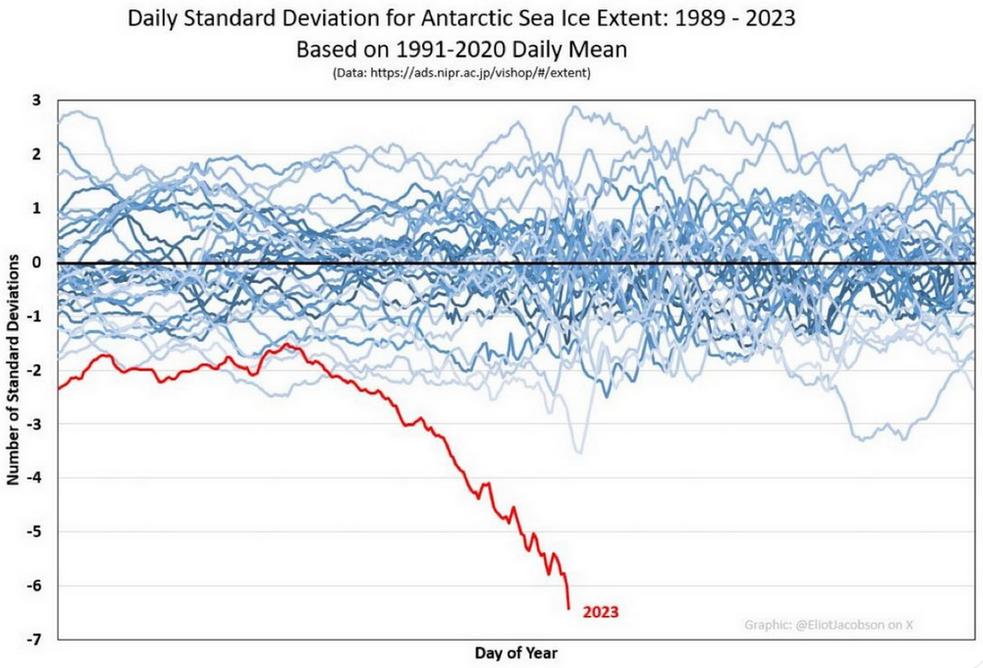 *
Some
have warned that sea level rise may be very rapid. Here is
a rather disturbing graph. If it's right it suggests that Antarctic ice
(and by inference, its glaciers) may indeed be suddenly starting to
melt at an accelerated pace. I got it in an email. I confess to not
checking out the source, which is given in the image.
*
Some
have warned that sea level rise may be very rapid. Here is
a rather disturbing graph. If it's right it suggests that Antarctic ice
(and by inference, its glaciers) may indeed be suddenly starting to
melt at an accelerated pace. I got it in an email. I confess to not
checking out the source, which is given in the image.
* In Niger it seems an American trained strongman has executed
a coup
against the American sponsored puppet government. Something in this
story is outrageous, but I'm not sure which part! Apparently France too
is very concerned and ready to fight because they get most of the
uranium for their
nuclear power plants from Niger. Hmm... after watching a video I see
that the factions and conflicts in Mali, Chad and Niger in this century
are almost beyond comprehension without many hours of study.
* Slavery has been almost ubiquitous throughout history. The
word "slave" comes from "Slav" as the Slavik peoples were often made
into slaves. Owens pointed out that white people were the first to
abolish slavery, and that it still goes on today.
I found it here: **IM PISSED!! Candice Owens Tells BLACK PEOPLE That
WHITE PEOPLE Didn't Invent Slavery They Ended It
https://www.youtube.com/watch?v=3jN51v6_IOo&ab_channel=DaRealAdogg
(I don't know where Owens' original video is.)
The world will never be at peace until all people are treated equally
and well.
* They are telling us that we should stop ranching and adopt a
vegetarian diet because cows fart and methane is released into the air,
so having cows contributes to global warming. Wow! It's sure a good
thing they killed off the plains buffalo in the 1800s, or we could all
be dead long since! Amazing we lasted until the 1800s! Before we go
after domestic cattle, surely we should shoot the huge herds of
wildebeests in South Africa.
(A couple of arguments against getting rid of cattle
and growing crops instead are that much range land is only suitable for
ranching, not crops, and that cow manure helps build better soil for
crop production.)
* Wheat Exports Deal Off With mediation by Turkey,
Russia agreed in July 2022 to help (with
minesweepers to sweep for Ukrainian mines near the ports and drifting
in the Black Sea as well as by not attacking grain ships) and not
hinder grain
exports from Ukraine, and to export grain and fertilizer itself, to
help stave off famine in poor countries. It
extended the agreement once or twice. Finally it refused to extend it
again. Why?
First, not a single one of the clauses of the deal that
were promised to allow Russian grain and fertilizer
exports as well as Ukrainian was ever implemented by the West. Only
things that benefited the West were implemented. In theory Russia could
export grain, but in practice the shipping procedures were all blocked
by Western
sanctions. Fund transfers to and
from Russia's agriculture bank, which were to have been enabled, were
still blocked, and grain ships to Russia couldn't get insurance.
Second, for the all Western moaning about "evil Russia,
blocking food supplies to poor, starving countries in Africa and Asia"
before the deal, only 3% of the grain ever went to them. The other 97%
went to higher paying nations, largely to Europe - even as hog feed
in Spain.
EU head Ursula van der Leyen said "The ball is in Russia's
court"
on extending the deal - as if the West had ever fulfilled the whole
agreement in the first place. Last I heard things are still getting
worse
and people are starving en masse in the poor countries that were
supposed to benefit from the deal.
Third, it seems Odessa and the safe shipping lanes were
being used by Ukraine as safe places from which to launch air and
seaborne drone
attacks on Crimea. After the attack on the 18(?)Km long Kirsch bridge
that connects Krasnodar by road and rail to Crimea ("a
legitimate military target" according to most) on the last night of the
grain deal, Russia has struck at Ukraine's military and grain
exporting operations, first in Odessa and then small ports. (There is
apparently also evidence at least for Odessa, that as ships came in for
grain, they brought in military supplies and fuel. ...I thought Turkey
was providing safeguards against that?) The attack on Reni just inside
Ukraine at the junction of Ukraine, Romania and Moldova in the Danube
river delta has probably ended the idea to export Ukrainian grains by
ship up the
Danube into Europe. (Already the shallowness of the river in the
ongoing European drought has held up the project. There has been talk
of dredging the river, which could be very bad environmentally.)
Once Russia had finally backed out of the deal, the UN
promised to enable fund transfers to unblock Russian agricultural trade
if it was reinstated. Does the UN have the power to make that happen?
Then where has it been for the last whole year as Russian requests to
implement what had already been agreed to were repeatedly ignored?
* It would be great to see an end to this needless and
senseless war, whose stated aim by Washington is weakening or
destroying Russia's government. That way Russia can be corrupted and
pillaged like Ukraine by the likes of the Bidens, bought up for
"pennies on the dollar". "Blackrock" has
acquired large business interests in Ukraine. I think they thought
Russia would just knuckle under under Washington's diverse pressures
like so many other countries have over the decades. Instead it has
tightened up internal security against devious foreign pressures and
its military has grown and adapted to become the most capable in
the world. If NATO and Russia fight directly, it presently appears NATO
would lose.
Ideally citizens throughout all
Ukraine's provinces/states ("oblasts" in local parlance) would
participate in their own comprehensive referendums to determine
their
desired national affiliations (maybe - voluntarily but with pressure
applied to participate on behalf of the citizens - along with Moldova
and Transnistria & (?) the West end of Poland that Stalin
transferred to Poland from Germany?)
In the absence of that, realistic negotiations by
nations
involved would
be welcome. These aren't possible while Washington insists that Russia
must abandon all the mostly ethnic Russian peoples of Zaparojjia,
Xerson,
Donetsk, Lugansk and even Crimea to the miserable treatment they were
getting (especially after 2014) in or from Ukraine. How could Russia do
that after the massive public vote in all these provinces for joining
Russia? (The vote was only under 90%
in Xerson, where it was around 80%. BTW, USA claims these referendums
were "rigged". How can it be qualified in any sense to pass judgment
when it refused to send - or even permit to be sent - any observers?
International observers who did go to see said it appeared to be
conducted fairly.) If Russia did abandon these regions, they would
have
to absorb the millions of refugees that would
result. (There are at least a couple of million in Russia now, but most
hope their stay is temporary. A lot have moved back to Mariupol as
dwellings and infrastructure are being repaired or rebuilt. Also there
are ten(?) million refugees of other ethnicities in Europe, who
apparently mostly say "I will never go back!" to Ukraine.) So Russia's
path
will be to continue increasing its forces and military production until
either the other side "gets real" about negotiating a settlement or
until it prevails militarily, marching
through Ukraine to the Polish border if need be. So far they have been
mostly content to have Ukraine's army hurl itself on their defenses
suffering
devastating losses for far smaller Russian losses and trivial
territorial gains. (Armored ground
vehicles don't fare well without air cover or protection from enemy
air, artillery and land mines, with target spotting from drones and
satellites.) Now Russia is increasing its mobilizations as Ukraine
sends more and more kids, old men and foreign mercenaries to the front
as cannon fodder in its apparently fruitless "counteroffensive".
The war hurts all, but one side or the other will become
economicly exhausted first if it continues. At the moment that appears
more likely to be the entire West before Russia. Ukraine is already a
wreck. Governments in Europe
supporting the war or Klaus Schuab's "World Economic Forum" policies
are starting to fall as elections come up. The Netherlands would
rather see farmers running their parliament than those who have been
supporting such agendas, and there is much clamor through Western
Europe for leaving or disbanding NATO. (I'd love to know what sort of
bribery was used on the governments to get long-neutral Sweden and
Finland to join NATO! The Finnish government soon fell after, but
somehow Finland is still in NATO.)
* I have had the thought that there maybe should be two referendums:
the first as stated, and an optional second one after it is seen how
things would look after the first one. This should only be held in
provinces
where the result looks geographicly awkward and people might change
their minds after seeing where it would leave them. For example, a
province might (conceivably) find itself separated geographicly from
other like-voting provinces that decided to form or join a country, or
be mostly surrounded by a different block. There might not be any need,
but it should be a stated policy in advance.
I could see the following as possibilities: (a) Ukrainian
ethnic areas create a new Ukraine. This would be smaller than the
present bloated boundaries wherein Ukraine is effectively in occupation
of foreign lands. (b) Russian ethnic areas join Russia. (c) Russian
ethnic areas form a new country "Novorussia" or whatever name. (d) Lvov
may or may not decide it is Polish again instead of Ukrainian. (e)
Moldovan citizens may or may not elect to become a province of Romania
instead of continuing to be "Europe's poorest nation". (e) Transnistria
(East of
Dniester river which has already declared itself independent of
Moldova) with all its ethnic Russians may decide to join "Novorussia"
or Russia assuming it is connected through Odessa.
Presently Russia is warning Poland not to intervene
militarily. (Stalin gave Lvov area to Ukraine in 1945 and Poland still
wants it back.) In the event of a plan for holding referendums, Russia
could welcome Poland's help, telling the present Ukrainian government
that the land is to be divided democraticly by referendums and that if
Kiev doesn't want to cooperate, Poland is ready to invade from the West
while Russia is invading from the East. That threat could end the war,
and even bring some good will between Poland and Russia. Poland might
have a better idea than I how likely it is that the present peoples of
Lvov would vote to rejoin it after all these decades.
All this may sound like "pie in the sky", and under
present conditions no doubt it is. But does it sound like a
potentially better way of running things than what is presently being
done? Is it only leaders' lack of imagination that prevent such
solutions? Some similar referendums were held after World War One over
100 years ago and boundaries were redefined. What else is involved?
greed? hatred? fear? ulterior
motives? Why are there people who want to tell other people what they
should do, how they should live and what they should think? And why do
they get away with it?
* I watched a video by "Vejon health" (Dr. Phillip MacMillan) which
talked about a study of autopsies by some of the world's most prominent
doctors and experts, which implicated covid vaccine in 75% of the
deaths. The preprint article submitted by them was deleted from Lancet
peer review journal's site even before peer review, in fact within 24
hours. Dr. Macmillan was quoting from a copy he had made when it was on
line. Soon his own video was removed by & from Youtube. On the 17th
I found that another channel, a religious one, had picked it up and
described the report. Unlike in past times, it is getting very hard to
cover up untoward things once they have become known!
ESD
(Eccentric Silliness Department)
* How come we flatten metal cans when we're done with them, but crumple
up flat paper?
* Prepeat: To do again before doing it the first time. (Then maybe you
can get it right the first time! Also see "Prehearsal")
* Antisceptic: A repellent to keep the skeptics away.
* Yeast may be Yeast (and Toast may be Toast), but a new package works
much better than one that expired a couple of years ago.
* How is a kilogram related to a diagram? (There must be some murderous
connection somewhere...)
"in depth
reports" for
each project are below. I hope they may be useful to anyone who wants
to get into a similar project, to glean ideas for how something
might be done, as well as things that might have been tried, or just
thought
of and not tried... and even of how not to do something - why
it didn't
work or proved impractical. Sometimes they set out inventive thoughts
almost as they occur - and are the actual organization and elaboration
in writing of those thoughts. They are thus partly a diary and are not
extensively proof-read for literary perfection, consistency,
completeness and elimination of duplications before
publication. I hope they may add to the body of wisdom for other
researchers and developers to help them find more productive paths and
avoid potential pitfalls and dead ends.
Electric
Transport
Magnetic Variable Torque Converter
[24th] Aside from my 'tennis elbow' injury making me reluctant to crawl
under the truck with heavy pieces, I thought I would have to do a lot
of trimming on the wooden housing to get the new poured copper rotor to
slide in, because it was just a bit bigger than the alume one and there
had been almost no clearance. That meant removing the housing from
under the truck and unscrewing everything. My biggest mental block was
not looking forward to doing all that - yet again! (But my bad back
that gets aggravated is better now!)
Now after all this time, I tried fitting the rotor in
anyway. It was touching the wood, but it slid into place. At first I
thought I could just file down the rotor a bit, but it would have been
too much, an besides, if it was bigger diameter it would have more
magnetic interaction, since the magnetic field doesn't end right at the
edge of the magnets on the magnet rotor. Even half an inch would
probably be beneficial, and it wasn't even close to that much larger.
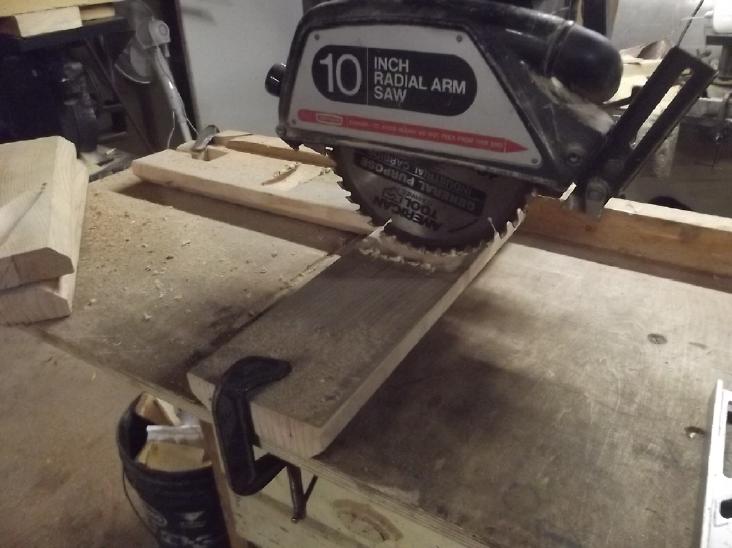 I still had to
cut some arc grooves around where it
rotated in operation, but not all the way along the housing. I took the
housing off and apart and made the cuts. I'm not sure how I would have
done them without setting up the radial arm saw in an unusual way.
Moving the saw forward and back, I went a little deeper and a little
deeper, cutting with the sides of the teeth.
I still had to
cut some arc grooves around where it
rotated in operation, but not all the way along the housing. I took the
housing off and apart and made the cuts. I'm not sure how I would have
done them without setting up the radial arm saw in an unusual way.
Moving the saw forward and back, I went a little deeper and a little
deeper, cutting with the sides of the teeth.
 Doubtless I cut somewhat
deeper and far wider than necessary, but I didn't want to find out it
wasn't quite there once it was all together again.
Doubtless I cut somewhat
deeper and far wider than necessary, but I didn't want to find out it
wasn't quite there once it was all together again.
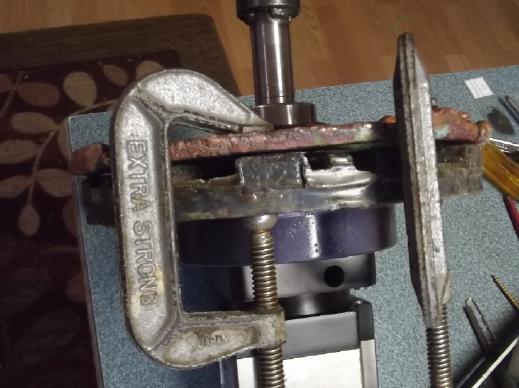 I tried to bend the copper rotor into better alignment
with C-clamps, but it didn't work well. It just sprang back.
I tried to bend the copper rotor into better alignment
with C-clamps, but it didn't work well. It just sprang back.
 [25th, 26th] In a couple
more sessions I fitted the rotor onto the
shaft and "flat" against the magnet rotor, grinding away high spots and
getting the alignment even around the rim. (What possessed me to cast
this ugly thing instead of just buying a piece of 1/4 inch, 10 inches
square, copper plate? Oh well, at least it's so rough (especially on
the back) it probably doesn't need heatsinks!)
[25th, 26th] In a couple
more sessions I fitted the rotor onto the
shaft and "flat" against the magnet rotor, grinding away high spots and
getting the alignment even around the rim. (What possessed me to cast
this ugly thing instead of just buying a piece of 1/4 inch, 10 inches
square, copper plate? Oh well, at least it's so rough (especially on
the back) it probably doesn't need heatsinks!)
[30th, 31st] I put the transmission back under the truck, and finally
tried it out. It moved, but the vibration was terrible. No doubt the
copper rotor is way out of balance. Why didn't I check it out
beforehand and try bolting weights onto it to balance it? Maybe I'll do
that now, or what I probably should have done in the first place:
bought a 10 by 10 inch copper plate and used that to make the rotor. An
incidental benefit of trying to cast the rotor, however, is thinking
about how to use oxy-hydrogen for casting - next article below!
Other
"Green"
& Electric Equipment
Projects
Oxy-hydrogen ("HHO") Gas: A Better Way? - with Reducing Flame
I was thinking about my
problems casting copper. First, the
crucible in the electric furnace didn't hold enough copper to do it in
one pour or even two or three. Second, it made for an oxidizing
environment wherein the copper turns to oxide, which melts at a much
higher temperature. Copper freezing prematurely, before I could pour it
or even in the crucible, seemed to be my main problem. It still looked
like copper, but doubtless it must have been slightly oxidized. I've
seen videos about making a wood burning furnace for alume, but not for
copper. It might have to be too hot for wood heat? Propane probably
isn't hot enough either. That leaves either more elaborate furnaces,
oxy-acetylene, or oxy-hydrogen. Oxy-hydrogen is sustainable - just
water instead of "fossil fuels".
I see two main problems with HHO gas torches as presently
constructed. First is safety. Having both gasses bubbling off the water
into one chamber and traveling through the same tube to the torch is
inherently dangerous. The whole tube can ignite and blow up right back
to and including the gas generator. (Oxy-acetylene has the hazard - and
considerable expense - of having bottles of compressed and explosive
gases lying around.) The second is that hydrogen and oxygen are
produced in exactly matching quantities. Once again, that makes for a
neutral to oxidizing burning environment that will turn copper to oxide.
But why are the gasses mixed right at the source? Of
course it's an ideal ratio for maximum temperature burning, but I think
it has more to do with simplicity of the gas generator, because that's
how it was done first and and until now, and so that's the mindset of
most makers. HHO has mostly been DIY ("do it yourself") until now,
although recently commercial units have become available.
What about a generator that sends the oxygen and the
hydrogen to separate places? This is more complex including needing two
lines and a torch with two valves, and thus would be more expensive.
But the same amount of electricity would produce the same amount of the
fuels.
And the approach solves both problems: the flame can't
burn back through the delivery tubes. It's safe and there's no need for
bubbling the gas through water and "check valves" to prevent this
"flashback". And by bleeding a little oxygen off away from the torch,
the flame can easily be turned from oxidizing to reducing. It would
still be done without compressors to compress and store pressurized
gasses in tanks, just the bubbling-off gasses going straight through
the tubes to the torch.
I say "torch", but of course for casting one prefers an
insulated furnace that a crucible can be placed inside. Whether I could
make a generator that makes enough gas at once to heat a large enough
furnace to cast a rotor in one pour as a DIY project is dubious. Maybe
if it was super insulated and one didn't mind it taking hours to melt
the copper? But in principle it could be done, and certainly starting
with water and ending with H2O vapor as the combustion
product is as environmentally benign and sustainable as the electricity
source, for which I (of course) nominate solar power.
Of course, the initial idea, separate gasses, only gets
one started down a rabbit hole. A little searching on youtube found
that separating the gasses is simply a matter of putting an interior
"lid" with a top connection over each electrode, since the gasses
always bubble upward. But to separate the electrodes requires a quite
different construction than most HHO generators. Robert Murray-Smith
made an HHO generator with graphite foil flat plates which prove to be
much more efficient and easier to make, and will last much longer, than
the stainless steel plates often made. And the "mythbusters" guys made
a generator that separated oxygen and hydrogen, and they collected the
hydrogen into a plastic bag.
This collection idea is interesting because one wouldn't
have to generate enough hydrogen and oxygen in real time if it can be
collected and used later. For example if it took two hours to generate
the hydrogen and then it was burned faster than it was being produced,
eg, in half an hour, an equally hot oven could be made using 1/4 as
much power. When the torch was to be run a weight could be placed on a
piece of plywood on each bag, or maybe just the plywood (making a sort
of "bellows"?), to give the gas pressure to flow from the bag to the
torch. But how big of bags would be needed for this? And would the
gasses in the bags not be dangerous?
I think if I do this at all I would try the simple "no gas
storage" first. In fact, if it doesn't get hot enough, I'd just make a
bigger one that takes more power. I don't want a big bag of explosive
hydrogen around anywhere!
Hmm... One could store solar power as hydrogen gas for
later cooking/heating use. Nah! There's that 1.1 million dollar
hydrogen powered bus that has exploded while being refueled this month.
No doubt all thoughtful precautions were taken in the making of both
the bus and the fueling station. I'll pass on DIY hydrogen storage!
July
Gardening
 Honeybees?
Honeybees?
Last year the bees I saw around most of the summer were small
bumblebees with blue on their backs. The prospects for having honeybees
move into my insulated beehive were discouraging, since I saw so few,
and those were in the spring.
 This summer however I haven't
seen
any of those. Instead when
the sun is shining I'm seeing what look like honeybees, on clover
plants and on my quinoa and sunflowers. (BTW the picture is upside down
to show the bee the right way up.) Another person also says honeybees
live on Haida Gwaii, but in the interior away from the coast. He says
here by the coast (where most of the people live) the sea salt from the
air gets into the wood of their hives and causes harmful mould to grow.
And it's cooler in summer by the ocean.
This summer however I haven't
seen
any of those. Instead when
the sun is shining I'm seeing what look like honeybees, on clover
plants and on my quinoa and sunflowers. (BTW the picture is upside down
to show the bee the right way up.) Another person also says honeybees
live on Haida Gwaii, but in the interior away from the coast. He says
here by the coast (where most of the people live) the sea salt from the
air gets into the wood of their hives and causes harmful mould to grow.
And it's cooler in summer by the ocean.
Apparently there's hope - they do exist! Evidently I
should be putting my hive out very early in the spring to have a chance
of a swarm deciding to move into it. In addition to insulating it I
waxed the wood so it shouldn't mould. I don't care to leave it out in
the weather if there are no bees in it, but it doesn't do much good
sitting in my storage room! [Insulated beehive: TE News #156, #157]
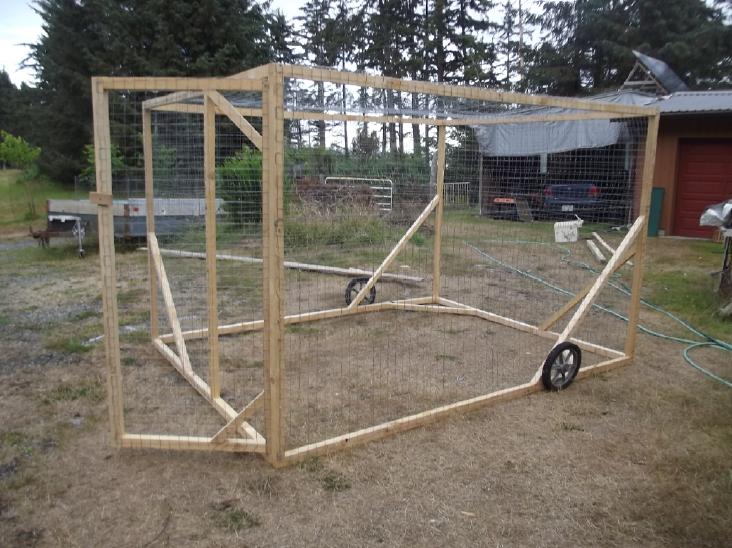 Chickens
Chickens
I made this yellow cedar, improved mobile chicken yard
8 feet by 10
and a little over 6 tall. I still need to make the wheels so they can
be active or retracted. I used stucco wire this time because raccoons
can rip chicken wire and get in.
It seemed pretty big when making it, but the idea was to
have the coop inside it, and the 4 by 6 foot chicken coop takes up too
much space, leaving only narrow corridors around the edges. I'll have
to make a new one that fits in better. Sigh!
As 4 of my 6 chickens are over three years old now (and 2
hens I was given this spring are two) I let them nest. I've had no eggs
all summer but there
are six chicks running around and one hen still sitting. (Do they
actually all stop laying because some are sitting? Why aren't there new
eggs?) Five chicks are running in and out through the wire. The other
hatched first and it has finally got too big to fit through the mesh.
Suddenly one hen wasn't getting along with the rest.
Others chased it whenever it left its nest, and in its running it
pecked and killed a chick. I couldn't let that continue. It was very
tough - the proverbial "rubber chicken". I had to turn it into soup.
(Let's see... auricanas, guacanas, unknown variety
rooster... I guess the chicks are purebred mongrels!)
Fasciata
 I
got a bromeliad, a fasciata, maybe 4 years ago, free at the plant
store. It had already bloomed and would die. But not without putting
out "pups" around the edges to take its place. I put it in a big pot.
The center died
and the three "pups" grew much larger than the original. Last summer
one of them had a flower, which lasted for ages and is even now still
attached. Now the other two have flowered. (This time I think I'll just
plant a couple of the pups in smaller pots.)
I
got a bromeliad, a fasciata, maybe 4 years ago, free at the plant
store. It had already bloomed and would die. But not without putting
out "pups" around the edges to take its place. I put it in a big pot.
The center died
and the three "pups" grew much larger than the original. Last summer
one of them had a flower, which lasted for ages and is even now still
attached. Now the other two have flowered. (This time I think I'll just
plant a couple of the pups in smaller pots.)
The interesting thing about bromeliads (which include
pineapples) is that their fresh sap can dissolve proteins. Every couple
of days I snip a bit off a leaf, add a few drops of distilled water,
grind it up, and put a couple of drops in my eyes with an eyedropper.
For a long time I thought nothing was happening, but a fine "veil" of
eye
floaters in my right eye and an old one (since age 16 or so) in my left
eye have lightened up considerably. It may also be dissolving the
beginnings of cataracts in the lenses.
Fruit Trees
I keep watering the two 'dead' Manregion English walnuts
daily, hoping one will come back from the roots. No luck so far. The
Carpathian one is growing beautifully (watering all fruit/nut trees
every other day), and hopefully the black walnut my brother is bringing
from Toronto will arrive alive and well.
There are a very few apples on two of the three trees.
I had planted my strawberry tree/bush in the garden in the
fall. I tossed a quart or two of water onto it almost daily through the
garden fence, which sat in a puddle under the bush as it was a slight
recess. Still it gradually died. I didn't know what was wrong, but now
I think
that for all my efforts it wasn't enough water; that it wasn't soaking
down to the roots. In the spring I pulled it up, then decided I would
put it in a pot and water it lots to try to get it to grow back from
the roots along with watering the two walnuts. I suppose I could order
another one. While it was in the greenhouse in a pot it grew nicely,
although it had no fruit. (But if I'm getting a Yamhill hazelnut, where
could I plant both bushes? I'm sure it has to be in the garden
protected from
the deer.)
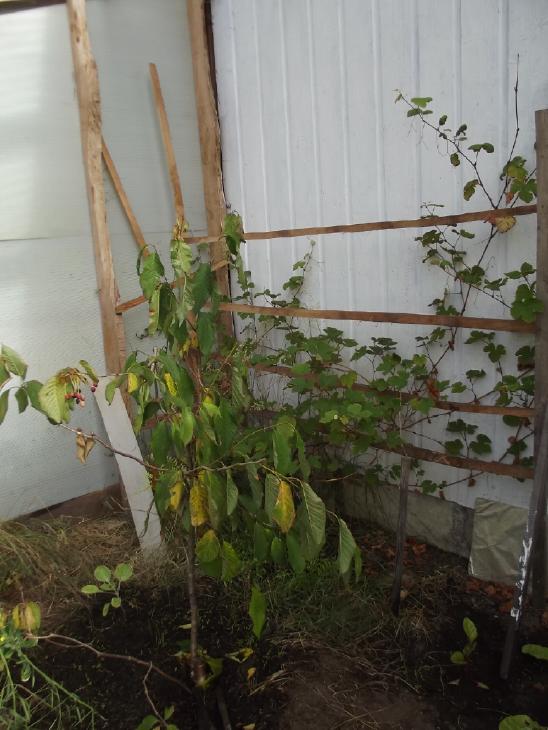 The cherry tree in the greenhouse also died over the winter. It's hard
to
remember to water in the winter and it obviously didn't get enough. The
one outside had its usual heavy crop: two cherries, but one withered
(in spite of lots of water). I decided to give up on that tree. In a
few
years it'll be in the shade of the walnut anyway. I asked the Funk It
store to order me another Bing cherry. I think I'm finally learning my
lesson about watering. I hope! But then I thought about the cherry
trees on the bank by the main wharf in town. They have nice cherries
with
good crops. I took a shovel and a small saw down there and found a
rather large sapling. It had been cut off and was now growing again out
the side of the chopped trunk. (Why won't my trees do that?) So I was
sure nobody wanted it! Digging in the rocks for half an hour I didn't
get many roots with it. I cut off over half the foliage and put it
where the other had been in the greenhouse near the grape vine. This
one I'm watering several times a day owing to the lack of roots. Still
many of the leaves have died. But not all!
The cherry tree in the greenhouse also died over the winter. It's hard
to
remember to water in the winter and it obviously didn't get enough. The
one outside had its usual heavy crop: two cherries, but one withered
(in spite of lots of water). I decided to give up on that tree. In a
few
years it'll be in the shade of the walnut anyway. I asked the Funk It
store to order me another Bing cherry. I think I'm finally learning my
lesson about watering. I hope! But then I thought about the cherry
trees on the bank by the main wharf in town. They have nice cherries
with
good crops. I took a shovel and a small saw down there and found a
rather large sapling. It had been cut off and was now growing again out
the side of the chopped trunk. (Why won't my trees do that?) So I was
sure nobody wanted it! Digging in the rocks for half an hour I didn't
get many roots with it. I cut off over half the foliage and put it
where the other had been in the greenhouse near the grape vine. This
one I'm watering several times a day owing to the lack of roots. Still
many of the leaves have died. But not all!
Gardens, Greenhouse
Here are some pictures. The main garden has become quite a
jungle. It seems like so much space when the plants are small, and then
they all grow and overlap.
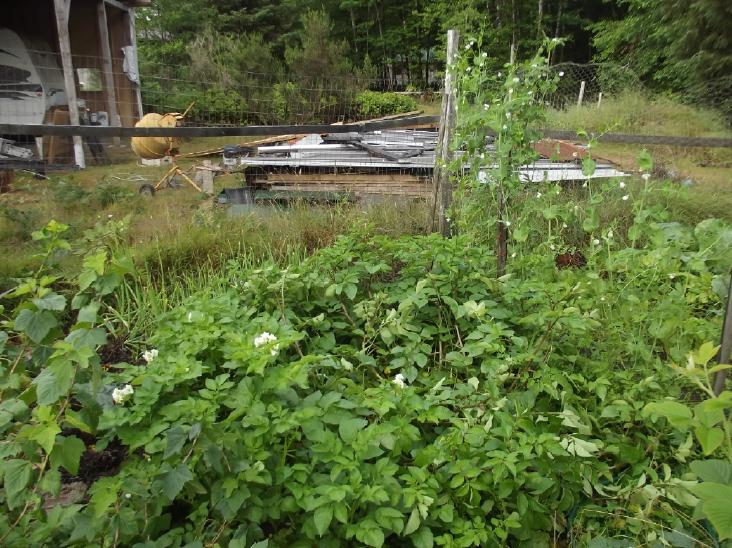 The corners of the main garden,
July 23rd: SE - potatos, onions, peas, rhubarb, black currents, josta
berries.
The corners of the main garden,
July 23rd: SE - potatos, onions, peas, rhubarb, black currents, josta
berries.
 SW - Romaine & carrots,
cabbages, beets, turnips, pod
peas (some grain that seeded itself - wheat?), bush & pole beans
SW - Romaine & carrots,
cabbages, beets, turnips, pod
peas (some grain that seeded itself - wheat?), bush & pole beans
 NW - Potatos & edge bushes:
blueberries,
beaked hazelnut.
NW - Potatos & edge bushes:
blueberries,
beaked hazelnut.
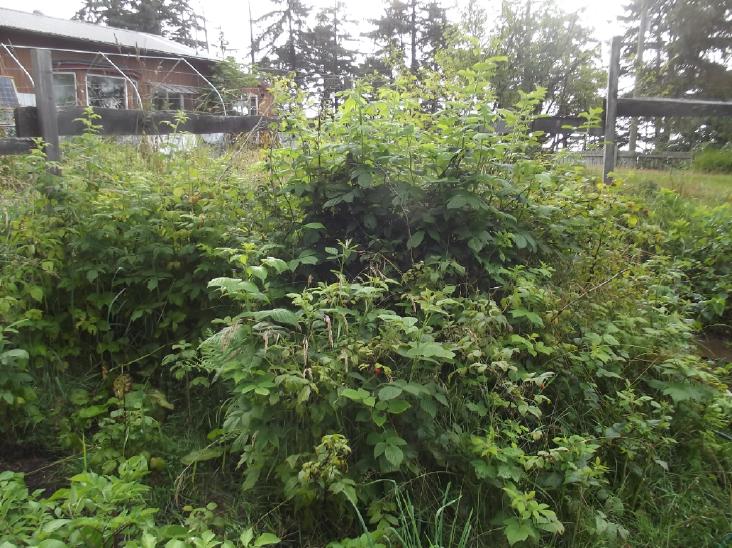
and NE - raspberry jungle.
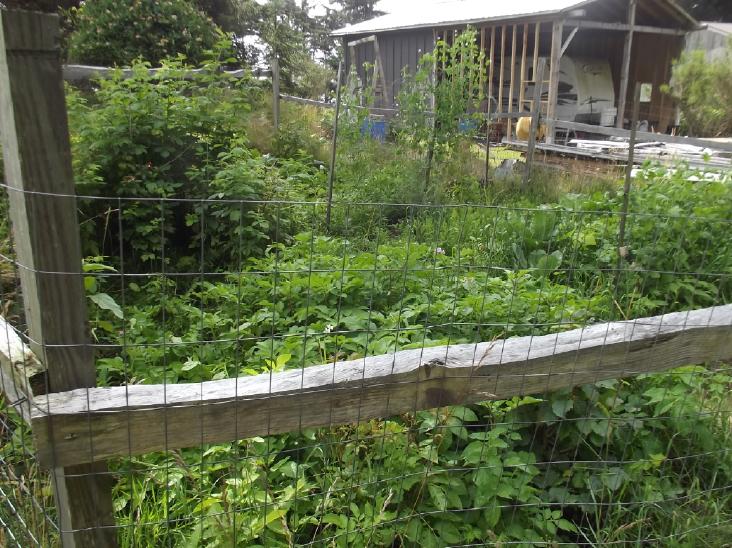 Main garden from the NW corner
looking to SE,
August 2nd, getting very overgrown.
Main garden from the NW corner
looking to SE,
August 2nd, getting very overgrown.
Mostly potatos in foreground, raspberries to left (got oodles of 'em!),
Typical garden vegetables on the south half. (HUGE
cabbages/cauliflowers!)
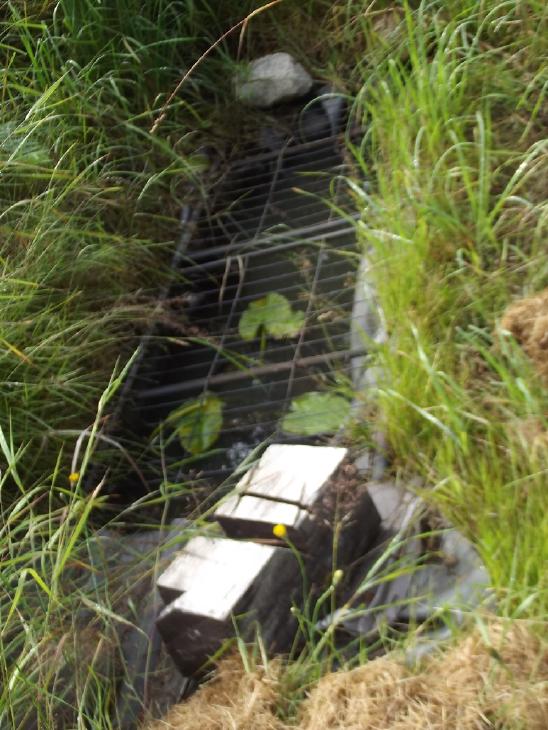 The goldfish pond by the garden
soon became
grown over.
The goldfish pond by the garden
soon became
grown over.
On the edge of a hill it's hard to get a mower near.
The three goldfish are still there "living off the land" (I don't feed
them)
...and I trust no otter, raccoon or great blue heron can get at them.
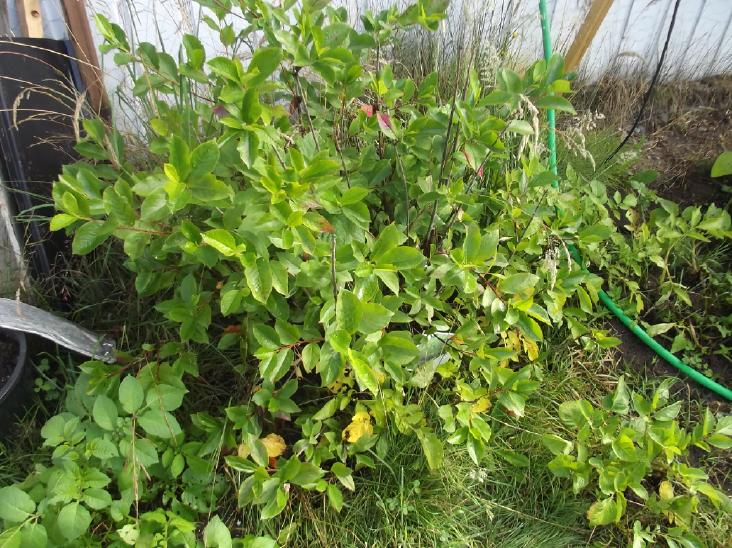 The chokeberry bush by the house.
Berries?
Maybe next year!
The chokeberry bush by the house.
Berries?
Maybe next year!
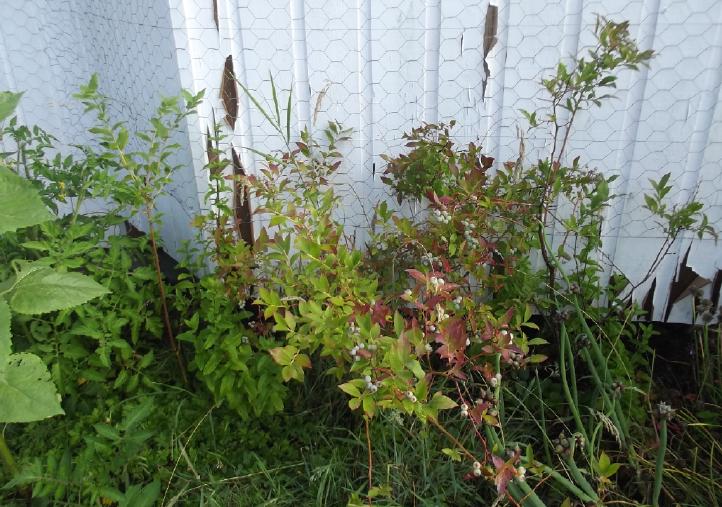 Blueberries getting ready to turn
blue in August
Blueberries getting ready to turn
blue in August
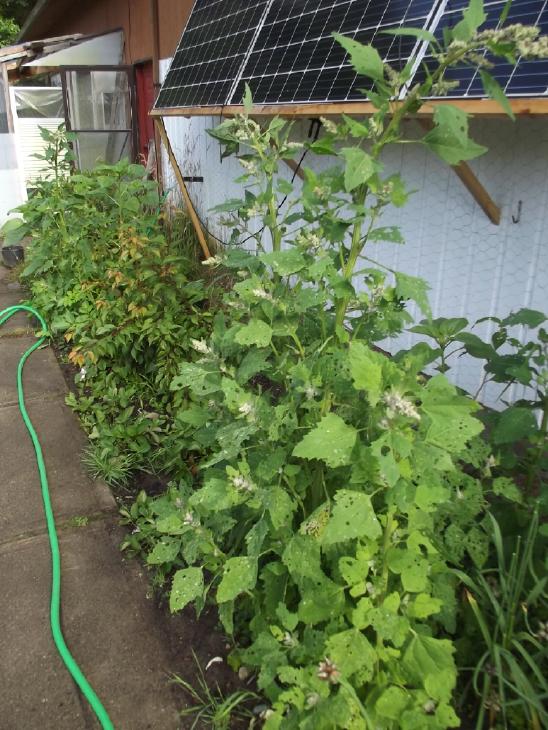 Quinoa, July 21st.
Quinoa, July 21st.
By August two or three kinds of caterpillars had turned the leaves to
skeletons,
then they went after the sunflowers, at which point I started picking
them off.
 Biggest sunflowers, July 21st.
Petals &
flower heads started early August.
Biggest sunflowers, July 21st.
Petals &
flower heads started early August.
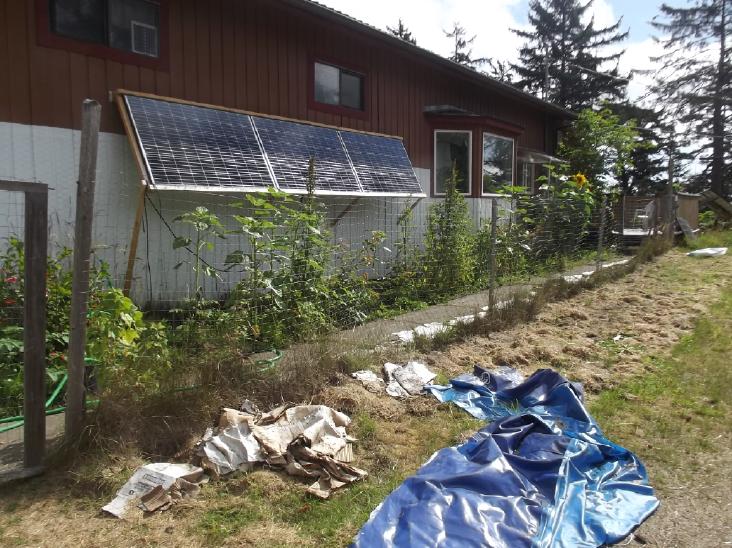 Garden by house, Aug 2nd:
Chokeberry,
sunflowers, quinoa, short apricot "bush", strawberries (got a lot),
Garden by house, Aug 2nd:
Chokeberry,
sunflowers, quinoa, short apricot "bush", strawberries (got a lot),
quinoa, garlic, tomatos, blueberries, chives, bigger sunflowers (the
ones planted earlier).
Next year I intend to move the fence out and have garden on both sides
of the sidewalk,
so I've put dried grass on the lawn as "mulch".
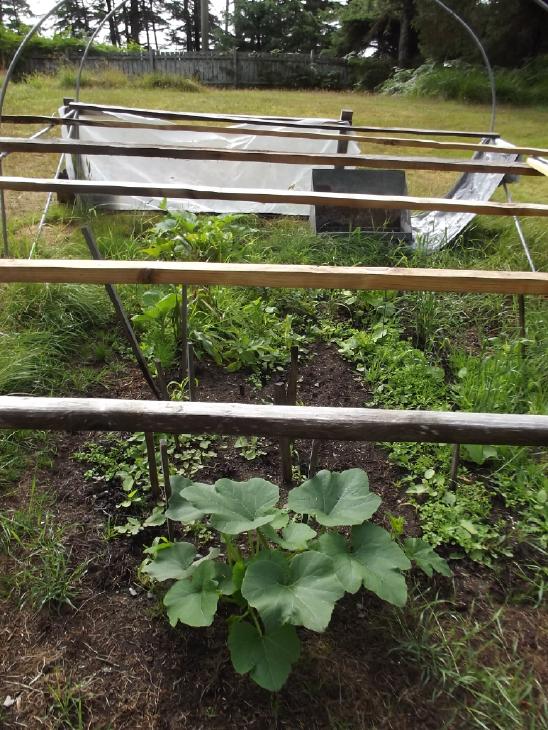 .
.
I tried making a corn patch in a cheap greenhouse.
The greenhouse cover blew off in early June and the corn didn't grow
well.
There were a couple of volunteer squashes and I added a couple more,
and some parsnips sprung up, so it wasn't a total write-off.
The deer got the volunteer cabbages.
Electricity
Storage
Lithium Ion Battery Resurrection from the Dead?
I started this in June, but
any improvement in a cell happened at such a glacial pace that I
elected to leave it out of that issue and start writing it here. But it
still hasn't been successful with even one cell. I don't know why but
somehow I'm not entirely convinced they can't be made to work again.
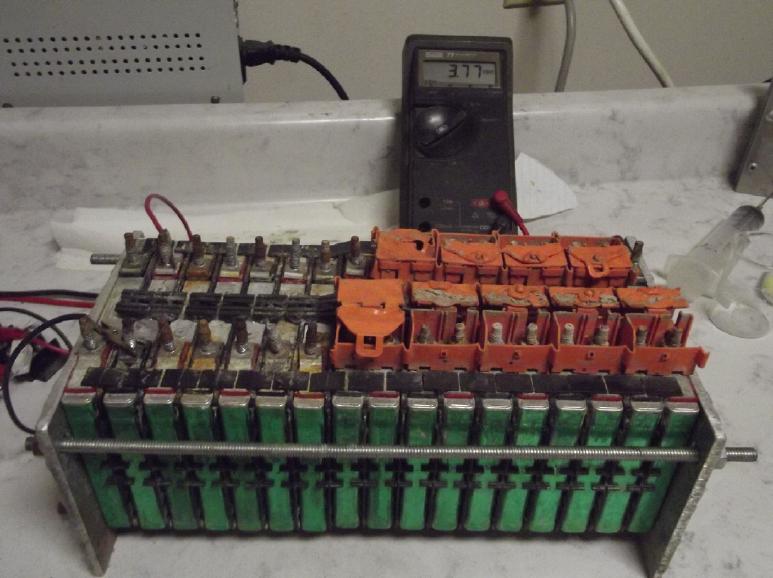 [June 22nd] Over 6 years
ago just before I moved, someone told me there
were batteries in a hybrid car that had been in a flood, free for the
removal. The removal turned out to be difficult. I extracted the dozens
of rather thin rectangular cells from the frame. They were crusted with
clay and quite dead. When I tried to charge a few, they ballooned up.
Why had I bothered? They were only a few amp-hours anyway. But for some
reason I've kept them, sitting under a bench in a tote all this time.
[June 22nd] Over 6 years
ago just before I moved, someone told me there
were batteries in a hybrid car that had been in a flood, free for the
removal. The removal turned out to be difficult. I extracted the dozens
of rather thin rectangular cells from the frame. They were crusted with
clay and quite dead. When I tried to charge a few, they ballooned up.
Why had I bothered? They were only a few amp-hours anyway. But for some
reason I've kept them, sitting under a bench in a tote all this time.
More recently I found out that these cells are supposed to
be held clamped together with plates on the ends. Finding that is what
gave me the idea of making an external clamp for my own cells, and got
me trying to make flat cells again.
But these cells still wouldn't charge. They seemed to be
charging and got up to around 3-1/2 volts, but then the current would
start going up instead of down, and the voltage immediately dropped
under 2 volts and continued falling when the charge was disconnected.
Now I decided to try heating them up to see if anything would change. I
set the kitchen oven to 255°F (~ 125°C) for 35 minutes and put
the whole clamped set in. The oven said it was up to temperature in
about 7-8 minutes. It smelled like hot plastic. But it wasn't hot
enough to melt the plastic pieces.
[June 29th] I set the power supply to 4.0V. Finally after trying the
first 5 cells at one end of the stack for a few hours each and becoming
quite pessimistic about the prospects of any of them working, I went
back to the second cell, which had seemed to hold its voltage for a
while. But was charging at 220mA just to hold its charge. This time I
left it on overnight and the next day. It started at ~500mA and
gradually went back down to 220. In 36 hours it was down to 180mA.
Could it possibly eventually drop to zero, or "negligible", eventually?
On checking things and fixing a poor connection I set the
supply to 4.06V (supply has no fine adjustment!) With the higher
voltage the current went up to 220mA again, but then soon down to 210.
This seemed to suggest a procedure: Charge the cell until
the current stopped dropping, then let it rest a few hours - or maybe
let it discharge - then charge again. Would the currents drop to near
zero after a few such 'cycles'? Would they all improve this way, or
just this one? I had dozens of them. They were free except for the
considerable labor I recall extracting them from the vehicle. In spite
of the geologic time it looked like it would take to do them all, it
seemed worth it - if it actually works. I would want to finish that
microcontroller based battery cycler I started on a few months ago.
[June 30th] AM: down to 170mA. Eve: Still 170mA. (Well, the idea had
seemed to be working!) I decided to shut it off for the night and try
again tomorrow. ~3.98V.
[July 1st (Canada Day)] It held to 3.62V overnight - still some charge
left. I put the charging back on. Naturally it started at the 1A limit
as it worked its way back up to 4V. It was down to 180mA by evening, an
still 170 the next morning.
[2nd] I think I'll give up and try another cell, #4. It started at
about 0V.
[8th] Back to that 2nd cell. Of course it was flat by now, but when
recharged this time the current went down to 140mA. Maybe discharging
and recharging is the key to bringing them back to life? Another day on
charge didn't get it any lower, and this time I decided to discharge it
through a 20Ω (2 x 10Ω resistors) to speed up the process. It went down
to 3.5V and I (thought I) disconnected the load. By morning it was down
to about 2 volts.
[12th] And now it was taking days at 1/4 amp to come back up even to
3.6 volts. Before it had happily gone up to 4 volts in a day or less.
Finally I decided to try something else... and discovered that while I
had connected the charge, I hadn't disconnected the discharge load
resistors. So I disconnected those, and in about 2 days it was up to 4
volts and the current was down to 130mA, the lowest yet.
I should connect a whole bunch of them in parallel through
current limiting resistors.
[31st] It finally occurred to me that these just might be lithium iron
phosphate cells rather than lithium ion or lithium polymer, and so
their charge voltage would be lower. This didn't quite make sense
because when put under load it took a long time to drop from 4.0V to
3.5V. But I decided to see how much current it took to keep it at 3.5V
insted of 4.0. A little lower, or a lot lower?
Hmm, a little lower, 90mA. Probably not LiFePO3. (That was
a silly idea anyway, since they kept dropping below 3.5V, probably to
0V again.)
Apparently if I'm not to just chuck the whole lot in the
garbage, the experiments will have to continue into August. Well, this
one did charge, even if the self discharge is - at least so far, and
refusing to drop further - too high to be practical.
Electricity
Generation
My Solar Power System
New Grid Tie Inverters, New Wiring
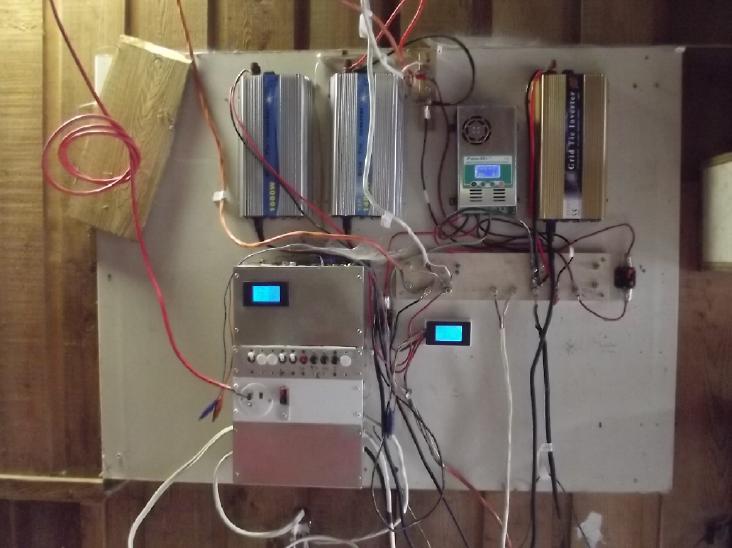 [17th] The two new 1000W
grid tie inverters I had ordered arrived in
the morning. I opened one and found it had a spare cooling fan in the
box. Must be a common part to fail? (The one moving part!) I went out
to the garage to replace the tie that kept resetting to zero watts and
gradually working its way up again, only to reset again just when it
hit full power. (Had its cooling fan failed? that might explain its
behavior.) As I removed the wires, the "minus" wire to the unit fell
off. A badly crimped on connector! (Not mine! That cable had come with
a piece of equipment.) A bad connection would be the first suspect, so
I re-crimped the connector and put it back together with the original
grid tie. But it was cloudy. Later the sun came out and the tie was
still powering gradually up-up-up and suddenly off again. I replaced it
with the new "gold" one. (Was its cooling fan working? I don't remember
hearing it. Wait, they have TWO cooling fans each!)
[17th] The two new 1000W
grid tie inverters I had ordered arrived in
the morning. I opened one and found it had a spare cooling fan in the
box. Must be a common part to fail? (The one moving part!) I went out
to the garage to replace the tie that kept resetting to zero watts and
gradually working its way up again, only to reset again just when it
hit full power. (Had its cooling fan failed? that might explain its
behavior.) As I removed the wires, the "minus" wire to the unit fell
off. A badly crimped on connector! (Not mine! That cable had come with
a piece of equipment.) A bad connection would be the first suspect, so
I re-crimped the connector and put it back together with the original
grid tie. But it was cloudy. Later the sun came out and the tie was
still powering gradually up-up-up and suddenly off again. I replaced it
with the new "gold" one. (Was its cooling fan working? I don't remember
hearing it. Wait, they have TWO cooling fans each!)
To continue the theme of
solar work, I had also just
purchased a plastic electrical box and a GFI receptacle. There was a
receptacle in the far wall of the garage to run a short wire from. I
wanted one on the outside of the same wall, in the carport, for the
carport
solar system. I had been running it all this time with a 50 foot
extension cord to an outdoor plug-in by the front entry.
 I drilled a
hole through the back of the box in the garage
and from there through the wall to the carport. I pre-wired the new
box. The rest of the job was more hazardous than might be expected.
Aside from connecting it live because I didn't know which breaker it
was, I had to move a bunch of lumber in racks in the carport, and there
was a hornets' next hanging from the ceiling. It was growing bigger
every day. I tried to move the boards with as little banging and
bumping as possible, and then left for a bit in between or if I thought
there were too many flying around in the carport. Finally I could get
in and I connected the wire to a pull wire, pulled it through into the
box in the garage, and made the connections. I left the new box
floating loose on the end of the wire like an extension cord with house
wire, electrical box and a ground fault breaker. I'll screw it to the
wall and pound in cable staples next winter when the wasps are gone!
I drilled a
hole through the back of the box in the garage
and from there through the wall to the carport. I pre-wired the new
box. The rest of the job was more hazardous than might be expected.
Aside from connecting it live because I didn't know which breaker it
was, I had to move a bunch of lumber in racks in the carport, and there
was a hornets' next hanging from the ceiling. It was growing bigger
every day. I tried to move the boards with as little banging and
bumping as possible, and then left for a bit in between or if I thought
there were too many flying around in the carport. Finally I could get
in and I connected the wire to a pull wire, pulled it through into the
box in the garage, and made the connections. I left the new box
floating loose on the end of the wire like an extension cord with house
wire, electrical box and a ground fault breaker. I'll screw it to the
wall and pound in cable staples next winter when the wasps are gone!
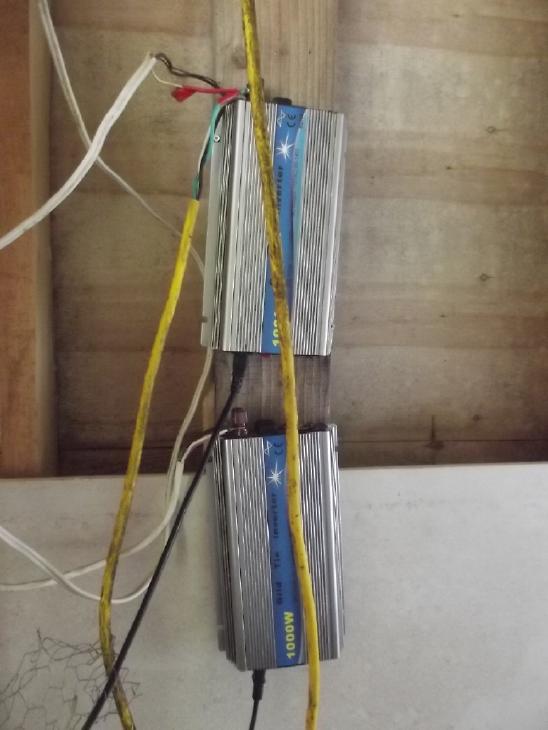 [18th] While I was on the
subject, I decided to take the poorly performing grid tie out to the
cabin where one grid tie was presently connecting all four panels. I
wanted to see if it would keep doing the same thing. If not, the cabin
would put out more energy with two more lightly loaded ties. If I
checked and found its fans weren't running, maybe I would try them out
on the bench and replace one if indicated.
[18th] While I was on the
subject, I decided to take the poorly performing grid tie out to the
cabin where one grid tie was presently connecting all four panels. I
wanted to see if it would keep doing the same thing. If not, the cabin
would put out more energy with two more lightly loaded ties. If I
checked and found its fans weren't running, maybe I would try them out
on the bench and replace one if indicated.
But it was cloudy and no grid tie cooling fans came on
anywhere. The cabin (4 collectors), which invariably produces a little
less than the the carport+pole (5 collectors), produced a little more
instead, 3.30KWH versus 2.87. I'll have to wait for a sunny day to
check out the tie's odd behavior.
[19th] Some sunshine just for a while. The grid tie now in the cabin
kept doing its trick and the cooling fans never came on, but now with
only 2 collectors driving it instead of 3, it would stay up at its
maximum for a couple of minutes before resetting. (425W - total 850W
from the two.) That meant it wasn't losing a lot of power, and I
decided to keep it there, assuming the daily readings looked good.
(They
were a little better than previously.)
I should probably try replacing one of the cooling fans
and seeing if it comes on. Some other time!
Meanwhile in the garage the 'house system' had readings of
1600-1700 watts with the sun shining. I hadn't seen over 14XX in quite
some time - and that
just before it would drop back to 10XX. The fans on the new 1000W grid
tie, powered by the three collectors now on the wall (915W rated), came
on more often than the other two (with two collectors on one and the
four old 250W collectors on the "1400W" unit).
In the
carport, the other
new grid tie, and the suspect 700W one
disconnected... and no long extension cord running around the
house!
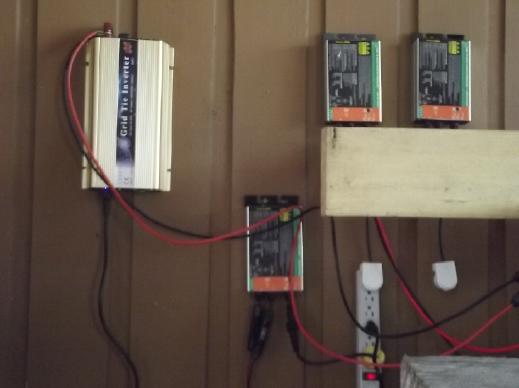 I finished off
by putting the other new grid tie in the
carport, on two of the three collectors on the 'sunniest' roof. Then I
moved the other collector from the "suspect" 700W grid tie to the one
freed
up. I did it all very gingerly and left the idle (suspect) grid tie
screwed onto the wall, with a growing hornet's nest over my head.
I finished off
by putting the other new grid tie in the
carport, on two of the three collectors on the 'sunniest' roof. Then I
moved the other collector from the "suspect" 700W grid tie to the one
freed
up. I did it all very gingerly and left the idle (suspect) grid tie
screwed onto the wall, with a growing hornet's nest over my head.
The Usual Daily/Monthly/Yearly Log of Solar
Power Generated [and grid power consumed]
(All times are in PST: clock 48 minutes ahead of local sun time, not
PDT which
is an hour and 48 minutes ahead. (DC) battery system power output
readings are reset to zero
daily (often just for LED lights, occasionally used with other loads:
Chevy Sprint electric car, inverters in power outages or other 36V
loads), while the
grid tied readings are cumulative.)
Daily Figures
Notes: House Main
meter (6 digits) accumulates. DC meter now
accumulates until [before] it loses precision (9.999 WH => 0010
KWH), then is
reset. House East and Cabin meters (4
digits) are reset to 0 when they get near 99.99 (which goes to "100.0")
- owing to loss of second decimal precision.
Km = Nissan Leaf electric car drove distance, then car was charged.
New Order of Daily Solar Readings (Beginning May 2022):
Date House, House, House, Cabin => Total KWH Solar [Notable
power
Uses (EV); Grid power meter@time] Sky/weather
Main
DC East Cabin
June
30th 130.86, 1.14, 21.09, 62.54 => 16.51 [55Km; 8366@21:00] Too cool
- had to turn on bedroom heat early AM. It shows!
July
1st 137.45, 1.48, 26.65, 67.37 => 17.32 [8378@22:00] Bedroom heat
burns electricity - and at the wrong time of day! Cloudy again.
2d 146.83, 1.59, 34.26, 74.18 => 23.91 [85Km; 8395@21:30]
Sunny & clear
3rd 157.39, 1.61, 40.97, 81.64 => 24.75 [8404@21:00] Clouded over
toward eve.
4th 167.72, 1.65, 45.30, 89.38 => 22.44 [50Km; 8416@21:00] Something
is wrong with a "700W" grid tie in the carport. Collection from carport
is half, and its light stays green even if it's unplugged from the AC.
The other two turn red if unplugged. Are the wired-in ones for 3x the
price more reliable? (Do you know if they've quit?) I have the two
1000W plugin ones coming, but I'm losing quite a lot of KWH through the
peak summer period!
5th 178.59, 1.68, 51.27, 96.26 => 23.75 [8423@21:00] 25° out!
Swapped two grid ties in carport - now the good one is on 2 panels
instead of 1. Cabin was off line for an hour midday. (3/4 KWH lost?)
6th 189.05, 1.75, 59.31, 7.76 => 26.33 [55Km;
8433@21:00] (best since May.) 26°!
7th 199.73, 1.80, 67.19, 12.29 => 23.14 [90Km; 8445@21:00]
Cabin was
off half the day ~ -3.5KWH? Not as warm out, still sunny & warm.
Very foggy eve.
8th 206.26, 1.87, 72.07, 14.93 => 13.84 [55Km; 8462@21:00;
50Km]
Cloudy, cooler.
9th 211.03, [off], 75.74, 18.22 => 11.73 [35Km; 8474@21:00] A few
drops ov rain. [using Sprint around acreage - unplugged DC]
10th 221.09, 2.11, 83.95, 25.57 => 25.93 [8480@22:00]
11th 229.79, 2.16, 91.03, 31.66 => 21.92 [65Km; 8493@21:00]
12th 239.84, 2.21, 99.18, 39.16 => 25.75 [8499@21:30]
13th 250.11, 2.24, 7.71, 46.54 => 25.39 [55Km;
8507@21:30]
14th 257.51, 2.26, 14.05, 51.68 => 18.90 [90Km; 8524@21:30] Jet
trails, clouds in PM
15th 260.20, 2.29, 15.88, 53.49 => 6.36 [55Km;
8537@22:30; 50Km] Rain! (Yay!)
16th 268.76, 2.31, 22.20, 59.41 => 20.83 [35Km; 8550@21:00] Not much
sun, but over 24° midday. Finished stucco wire covering and door of
new chicken enclosure.
17th 275.49, 2.34, 27.46, 64.03 => 16.64 [8556@20:30] Rain
overnight. Mostly cloudy. Solar work (new grid tie, AC wiring) as noted
above.
18th 280.59, 2.38, 30.33, 67.33 => 11.31 [8562@21:00] mor cloudz.
19th 287.01, 2.41, 34.66, 71.33 => 14.78 [55Km; 8577@21:00] A bit
more solar work.
20th 293.19, 2.44, 38.73, 75.29 => 14.24 [8581@21:00] Seemed cloudy
all day, but some of it sure looked like spread-out jet trail haze
obscuring the whole sky. Otherwise, I'm pretty sure there'd have been
some sunny periods. Later afternoon it sprinkled very lightly, off and
on. (I know from Victoria that's a June-July trick to keep you from
watering the garden, which will continue wilting!)
21st 300.88, 2.47, 44.28, 80.14 => 18.12 [90Km; 8597@21:30]
22d 306.77, 2.53, 48.39, 83.79 => 13.71 [55Km; 8614@21:30;
50Km]
23rd 314.31, 2.59, 53,83, 88.88 => 18.13 [45Km; 8624@21:00] A bit of
sun.
24th 317.99, 2.63, 56.18, 90.76 => 7.95 [8636@20:30]
Clouds & drizzle.
25th 327.15, 2.69, 62.75, 95.60 => 20.63 [8642@20:30] Some actual
sunshine today! Cloudy AM. (Cabin was disconnected for a little while.)
26th 334.06, 2.72, 67.64, 4.47 => 16.30 [8648@21:00; 50Km]
(Charged car daytime 27th)
27th 344.64, 2.74, 75.13, 11.31 => 24.93 [8656@21:00] Sunny! (A few
light jet trails) Days getting shorter - no more of 25-28 KWH this
year!
28th 356.23, 3.00, 83.15, 18.45 => 27.01 [85Km; 8667@20:30] Another
great sunny day! 20° in the shade! (Oops, did I say no more 25-28s?)
29th 359.75, 3.02, 85.56, 20.79 => 8.29 [55Km;
8683@20:00; 50Km] Heavy rain before dawn w. thunder, cloudy, more rain
during day.
30th 364.21, 3.05, 88.61, 23.60 => 10.35 [35Km; 8699@20:30] More
thunder! Twice in the same year?
31th 367.85, 3.09, 91.07, 25.89 => 8.43 [8709@20:30] More
rain. Not unusual!
August
1st 374.10, 3.15, 95.14, 29.85 => 14.34 [8717@23:00]
2d 384.29, 3.23, 7.33, 36.12 => 23.87
[8721@20:00] Dug trench & put in forms for 2nd last section of
concrete on cabin. Did in my elbow.
3rd 396.19, 3.26, 15.42, 43.32 => 27.22 [55Km; 8731@21:00] Sunny
Day! (light jet trails)
4th 405.61, 3.30, 21.70, 49.14 => 21.56 [8736@20:30]
5th 411.52, 3.33, 25.74, 52.91 => 13.75 [100Km; 8756@21:00; 50Km]
6th 420.22, 3.36, 32.22, 57.93 => 20.23 [45Km; 8769@21:00]
Put
plywood on next section of cabin wall. Now as long as it doesn't rain
until I've put the plastic on tomorrow...
7th 422.40, 3.39, 33.58, 59.10 => 4.76 [8776@20:30]
Rain, wind, rain & wind; working on ladders. (bletch!)
8th 426.58, 3.42, 36.61, 61.62 => 9.76 [55Km; 8791@20:30]
More drizzle & cloud. No wind.
9th 430.99, 3.49, 39.64, 64.42 => 10.31 [8798@20:30] Bit of drizzle
but mostly just cloud.
10th 435.66, 3.68, 42.94, 67.58 => 11.32 [8804@21:00] Poured next
(2nd last) section of footing on the cabin.
11th 441.58, 3.72, 47.39, 71.52 => 14.35 [8811@20:00]
Chart of daily KWH from solar panels.
(Compare July 2023
(left) with June 2023 & with July 2022.)
Days of
__ KWH
|
July 2023
(18..17..18)
collectors)
|
June 2023
(18..15..17..15
..18 collectors)
|
July 2022
(18 s. panels)
|
0.xx
|
|
|
|
1.xx
|
|
|
|
2.xx
|
|
|
|
3.xx
|
|
|
|
4.xx
|
|
|
|
5.xx
|
|
|
|
6.xx
|
1
|
|
1
|
7.xx
|
1
|
1
|
2
|
8.xx
|
2
|
|
3
|
9.xx
|
|
1
|
|
10.xx
|
1
|
|
|
11.xx
|
2
|
1
|
2
|
12.xx
|
|
1
|
2
|
13.xx
|
2
|
2
|
2
|
14.xx
|
2
|
1
|
1
|
15.xx
|
|
2
|
1
|
16.xx
|
2
|
4
|
4
|
17.xx
|
1
|
2
|
|
18.xx
|
3
|
2
|
2
|
19.xx
|
|
|
|
20.xx
|
2
|
5
|
|
21.xx
|
1
|
3
|
2
|
22.xx
|
1
|
|
|
23.xx
|
3
|
2
|
1
|
24.xx
|
2
|
1
|
2
|
25.xx
|
3
|
2
|
1
|
26.xx
|
1
|
|
|
27.xx
|
1
|
|
4
|
28.xx
|
|
|
|
29.xx
|
|
|
1
|
Total KWH
for month
|
563.31
|
540.12
|
519.37
|
Km Driven
on Electricity
|
1348.1 Km
(180 KWH?)
|
1407.7 Km
(190 KWH?)
|
1100 Km
(~160? KWH?) |
Things Noted - July 2023
* In May, June and July the solar collectors made more KWH than were
used from the power grid. (In addition to having the most solar
collection, those are months I don't need much heat in the bedroom
at night, and I don't have heat on to keep the travel trailer from
getting mouldy.)
* Sunshine: May was sunnier than
June. The first half of July was sunny with almost no rain, then it was
clouds and jet trails with light rains.
* The solar power seems to make more energy than the Leaf EV car uses
except in
November, December and January.
Monthly Summaries: Solar Generated KWH [& Power used from
grid KWH]
As these tables are getting long, I'm not repeating the log of monthly
reports. The reports for the first four full years (March 2019 to
February 2023) may be found in TE
News
#177,
February
2023.
2023 - (House roof, lawn + DC + Cabin + Carport, Pole) Solar
Jan KWH: 40.57 + 3.06 + 28.31 + 21.85 = 93.79 Solar [grid: 1163; car
(these are very rough estimates): 130]
Feb KWH: 59.19 + 2.70 + 38.10 + 32.47 = 132.46 Solar [grid: 1079; car:
110]
(Four years of solar!)
Mar KWH: 149.49 + 2.72 + 53.85 + 92.08 = 298.14 Solar
[grid: 981; car:
140]
Apr KWH: 176.57 + 2.71 + 121.21 + 108.34 = 408.83 [grid: 676; car: 160]
May KWH:266.04 + 2.04 + 194.13 + 180.31 = 642.52 [grid: 500; car: 175]
Jun KWH: 237.55 + 3.70 + 172.56 + 126.31 = 540.12 [grid: 464; car: 190]
July KWH:236.99 + 1.95 + 169.16 + 155.21 = 563.31 [grid: 343; car: 180]
Annual Totals
1. March 2019-Feb. 2020: 2196.15 KWH Solar [used 7927 KWH
from grid]
2. March 2020-Feb. 2021: 2069.82 KWH Solar [used 11294 KWH from grid]
(More electric heat - BR, Trailer & Perry's RV)
3. March 2021-Feb. 2022: 2063.05 KWH Solar [used 10977 KWH from grid]
4a. March 2022-August 2022: in (the best) 6 months, about 2725 KWH
solar - more than in any previous entire year!
4. March2022-Feb. 2023: 3793.37 KWH Solar [used 12038 KWH from grid]
Money Saved or Earned - @ 12¢ [All BC residential elec.
rate] ; @
50¢ [2018 cost of diesel fuel to BC Hydro] ; @ 1$ per KWH [actual
total
cost to BC Hydro
in 2022 according to an employee]:
1. 263.42$ ; 1097.58$ ; 2196.15$
2. 248.38$ ; 1034.91$ ; 2069.82$
3. 247.57$ ; 1031.53$ ; 2063.05$
4. 455.20$ ; 1896.69$ ; 3793.37$
It can be seen that the benefit to the society as a whole
on Haida Gwaii from solar power installations is much greater than the
cost savings to the individual user of electricity, thanks to the heavy
subsidization of our power
owing to the BC government policy of having the same power rate across
the entire province regardless of the cost of production. And it can be
insurance: With some
extra equipment and a battery, sufficient solar can deliver essential
power in
electrical outages however long. (Feb 28th 2023: And it's probably well
over 1$/KWH by now the way inflation of diesel fuel and other costs is
running.)
https://www.TurquoiseEnergy.com
Haida Gwaii, BC Canada

 I got just a
few little things done. The new rotor being a bit bigger diameter, I
had to cut some grooves in the housing boards so it would fit in.
I got just a
few little things done. The new rotor being a bit bigger diameter, I
had to cut some grooves in the housing boards so it would fit in. With some
fiddling around, filing and grinding, I did make the cast copper rotor
essentially fit, put the assembly on
the truck and turned it on. The truck moved at motor "idle" speed on
flat concrete,
but the messy cast copper rotor was so out of balance that I didn't
dare press very hard on the pedal owing to the intense vibrations. I
certainly wasn't going to try going anywhere. I suppose this was fully
predictable. I'll have to balance it by attaching weights before I try
again.
With some
fiddling around, filing and grinding, I did make the cast copper rotor
essentially fit, put the assembly on
the truck and turned it on. The truck moved at motor "idle" speed on
flat concrete,
but the messy cast copper rotor was so out of balance that I didn't
dare press very hard on the pedal owing to the intense vibrations. I
certainly wasn't going to try going anywhere. I suppose this was fully
predictable. I'll have to balance it by attaching weights before I try
again.
 I was getting
various things done around the acreage over
July, and one of them was I decided not to use lawn grass to insulate
the cabin walls. Instead I'll use commercial cellulose fiber. Grass
worked out to about R3 and cellulose is R4, which is 33% better
insulation. And cellulose fiber is a well known, fire retardant
material which will surely
break down in the environment. Fiberglass is itchy and "never" breaks
down. To fluff up the compacted cellulose in the bags, I plan to use
something like a paint stirrer on
an electric drill at a good speed, starting by dumping clumps of the
material into a garbage can - or maybe some pail with a good spout.
Then I'll just pour it down the walls by leaving a strip at the top
without gyproc until it's filled... and the same thing for the roof. I
plan to sheet in the rafters the same as the walls, rather than have an
attic space.
I was getting
various things done around the acreage over
July, and one of them was I decided not to use lawn grass to insulate
the cabin walls. Instead I'll use commercial cellulose fiber. Grass
worked out to about R3 and cellulose is R4, which is 33% better
insulation. And cellulose fiber is a well known, fire retardant
material which will surely
break down in the environment. Fiberglass is itchy and "never" breaks
down. To fluff up the compacted cellulose in the bags, I plan to use
something like a paint stirrer on
an electric drill at a good speed, starting by dumping clumps of the
material into a garbage can - or maybe some pail with a good spout.
Then I'll just pour it down the walls by leaving a strip at the top
without gyproc until it's filled... and the same thing for the roof. I
plan to sheet in the rafters the same as the walls, rather than have an
attic space. One might
wonder why I made mostly 2 by 4 walls
instead of
the presently more common 2 by 6 standards. Well, the ways we heat
(& cool)
homes are energy hogs, and presently energy is costly. But I see the
value of such thick walls as a temporary situation, not
long term. What do I expect will change?
One might
wonder why I made mostly 2 by 4 walls
instead of
the presently more common 2 by 6 standards. Well, the ways we heat
(& cool)
homes are energy hogs, and presently energy is costly. But I see the
value of such thick walls as a temporary situation, not
long term. What do I expect will change? By the end of
the month I finally had the next wall section framed. The trench and
form
was done for casting the next concrete footing on August 2nd (in doing
which I hurt my elbow again) and the travel trailer was out on the 3rd
or 4th. For the first time the interior is clear and I can work on all
parts of it.
By the end of
the month I finally had the next wall section framed. The trench and
form
was done for casting the next concrete footing on August 2nd (in doing
which I hurt my elbow again) and the travel trailer was out on the 3rd
or 4th. For the first time the interior is clear and I can work on all
parts of it. I have a case
in mind. In 1969 as single-use plastics were just starting to come into
widespread use, a petroleum institute study concluded that there was no
way to get rid of waste plastics other than to incinerate - burn -
them. Since then thousands of times as much plastic has accumulated in
the environment everywhere throughout the world. Plastic recycling is
virtually a scam, recycling up to just 9% of all the plastics consumers
conscientiously separate into the recycling bins. And probably more
petroleum product is burned as fuel in trucks carting it around than is
actually contained in the plastic!
I have a case
in mind. In 1969 as single-use plastics were just starting to come into
widespread use, a petroleum institute study concluded that there was no
way to get rid of waste plastics other than to incinerate - burn -
them. Since then thousands of times as much plastic has accumulated in
the environment everywhere throughout the world. Plastic recycling is
virtually a scam, recycling up to just 9% of all the plastics consumers
conscientiously separate into the recycling bins. And probably more
petroleum product is burned as fuel in trucks carting it around than is
actually contained in the plastic! *
Some
have warned that sea level rise may be very rapid. Here is
a rather disturbing graph. If it's right it suggests that Antarctic ice
(and by inference, its glaciers) may indeed be suddenly starting to
melt at an accelerated pace. I got it in an email. I confess to not
checking out the source, which is given in the image.
*
Some
have warned that sea level rise may be very rapid. Here is
a rather disturbing graph. If it's right it suggests that Antarctic ice
(and by inference, its glaciers) may indeed be suddenly starting to
melt at an accelerated pace. I got it in an email. I confess to not
checking out the source, which is given in the image. I still had to
cut some arc grooves around where it
rotated in operation, but not all the way along the housing. I took the
housing off and apart and made the cuts. I'm not sure how I would have
done them without setting up the radial arm saw in an unusual way.
Moving the saw forward and back, I went a little deeper and a little
deeper, cutting with the sides of the teeth.
I still had to
cut some arc grooves around where it
rotated in operation, but not all the way along the housing. I took the
housing off and apart and made the cuts. I'm not sure how I would have
done them without setting up the radial arm saw in an unusual way.
Moving the saw forward and back, I went a little deeper and a little
deeper, cutting with the sides of the teeth. I tried to bend the copper rotor into better alignment
with C-clamps, but it didn't work well. It just sprang back.
I tried to bend the copper rotor into better alignment
with C-clamps, but it didn't work well. It just sprang back. Honeybees?
Honeybees? This summer however I haven't
seen
any of those. Instead when
the sun is shining I'm seeing what look like honeybees, on clover
plants and on my quinoa and sunflowers. (BTW the picture is upside down
to show the bee the right way up.) Another person also says honeybees
live on Haida Gwaii, but in the interior away from the coast. He says
here by the coast (where most of the people live) the sea salt from the
air gets into the wood of their hives and causes harmful mould to grow.
And it's cooler in summer by the ocean.
This summer however I haven't
seen
any of those. Instead when
the sun is shining I'm seeing what look like honeybees, on clover
plants and on my quinoa and sunflowers. (BTW the picture is upside down
to show the bee the right way up.) Another person also says honeybees
live on Haida Gwaii, but in the interior away from the coast. He says
here by the coast (where most of the people live) the sea salt from the
air gets into the wood of their hives and causes harmful mould to grow.
And it's cooler in summer by the ocean. Chickens
Chickens I
got a bromeliad, a fasciata, maybe 4 years ago, free at the plant
store. It had already bloomed and would die. But not without putting
out "pups" around the edges to take its place. I put it in a big pot.
The center died
and the three "pups" grew much larger than the original. Last summer
one of them had a flower, which lasted for ages and is even now still
attached. Now the other two have flowered. (This time I think I'll just
plant a couple of the pups in smaller pots.)
I
got a bromeliad, a fasciata, maybe 4 years ago, free at the plant
store. It had already bloomed and would die. But not without putting
out "pups" around the edges to take its place. I put it in a big pot.
The center died
and the three "pups" grew much larger than the original. Last summer
one of them had a flower, which lasted for ages and is even now still
attached. Now the other two have flowered. (This time I think I'll just
plant a couple of the pups in smaller pots.) The cherry tree in the greenhouse also died over the winter. It's hard
to
remember to water in the winter and it obviously didn't get enough. The
one outside had its usual heavy crop: two cherries, but one withered
(in spite of lots of water). I decided to give up on that tree. In a
few
years it'll be in the shade of the walnut anyway. I asked the Funk It
store to order me another Bing cherry. I think I'm finally learning my
lesson about watering. I hope! But then I thought about the cherry
trees on the bank by the main wharf in town. They have nice cherries
with
good crops. I took a shovel and a small saw down there and found a
rather large sapling. It had been cut off and was now growing again out
the side of the chopped trunk. (Why won't my trees do that?) So I was
sure nobody wanted it! Digging in the rocks for half an hour I didn't
get many roots with it. I cut off over half the foliage and put it
where the other had been in the greenhouse near the grape vine. This
one I'm watering several times a day owing to the lack of roots. Still
many of the leaves have died. But not all!
The cherry tree in the greenhouse also died over the winter. It's hard
to
remember to water in the winter and it obviously didn't get enough. The
one outside had its usual heavy crop: two cherries, but one withered
(in spite of lots of water). I decided to give up on that tree. In a
few
years it'll be in the shade of the walnut anyway. I asked the Funk It
store to order me another Bing cherry. I think I'm finally learning my
lesson about watering. I hope! But then I thought about the cherry
trees on the bank by the main wharf in town. They have nice cherries
with
good crops. I took a shovel and a small saw down there and found a
rather large sapling. It had been cut off and was now growing again out
the side of the chopped trunk. (Why won't my trees do that?) So I was
sure nobody wanted it! Digging in the rocks for half an hour I didn't
get many roots with it. I cut off over half the foliage and put it
where the other had been in the greenhouse near the grape vine. This
one I'm watering several times a day owing to the lack of roots. Still
many of the leaves have died. But not all!










 .
. [June 22nd] Over 6 years
ago just before I moved, someone told me there
were batteries in a hybrid car that had been in a flood, free for the
removal. The removal turned out to be difficult. I extracted the dozens
of rather thin rectangular cells from the frame. They were crusted with
clay and quite dead. When I tried to charge a few, they ballooned up.
Why had I bothered? They were only a few amp-hours anyway. But for some
reason I've kept them, sitting under a bench in a tote all this time.
[June 22nd] Over 6 years
ago just before I moved, someone told me there
were batteries in a hybrid car that had been in a flood, free for the
removal. The removal turned out to be difficult. I extracted the dozens
of rather thin rectangular cells from the frame. They were crusted with
clay and quite dead. When I tried to charge a few, they ballooned up.
Why had I bothered? They were only a few amp-hours anyway. But for some
reason I've kept them, sitting under a bench in a tote all this time. [17th] The two new 1000W
grid tie inverters I had ordered arrived in
the morning. I opened one and found it had a spare cooling fan in the
box. Must be a common part to fail? (The one moving part!) I went out
to the garage to replace the tie that kept resetting to zero watts and
gradually working its way up again, only to reset again just when it
hit full power. (Had its cooling fan failed? that might explain its
behavior.) As I removed the wires, the "minus" wire to the unit fell
off. A badly crimped on connector! (Not mine! That cable had come with
a piece of equipment.) A bad connection would be the first suspect, so
I re-crimped the connector and put it back together with the original
grid tie. But it was cloudy. Later the sun came out and the tie was
still powering gradually up-up-up and suddenly off again. I replaced it
with the new "gold" one. (Was its cooling fan working? I don't remember
hearing it. Wait, they have TWO cooling fans each!)
[17th] The two new 1000W
grid tie inverters I had ordered arrived in
the morning. I opened one and found it had a spare cooling fan in the
box. Must be a common part to fail? (The one moving part!) I went out
to the garage to replace the tie that kept resetting to zero watts and
gradually working its way up again, only to reset again just when it
hit full power. (Had its cooling fan failed? that might explain its
behavior.) As I removed the wires, the "minus" wire to the unit fell
off. A badly crimped on connector! (Not mine! That cable had come with
a piece of equipment.) A bad connection would be the first suspect, so
I re-crimped the connector and put it back together with the original
grid tie. But it was cloudy. Later the sun came out and the tie was
still powering gradually up-up-up and suddenly off again. I replaced it
with the new "gold" one. (Was its cooling fan working? I don't remember
hearing it. Wait, they have TWO cooling fans each!) I drilled a
hole through the back of the box in the garage
and from there through the wall to the carport. I pre-wired the new
box. The rest of the job was more hazardous than might be expected.
Aside from connecting it live because I didn't know which breaker it
was, I had to move a bunch of lumber in racks in the carport, and there
was a hornets' next hanging from the ceiling. It was growing bigger
every day. I tried to move the boards with as little banging and
bumping as possible, and then left for a bit in between or if I thought
there were too many flying around in the carport. Finally I could get
in and I connected the wire to a pull wire, pulled it through into the
box in the garage, and made the connections. I left the new box
floating loose on the end of the wire like an extension cord with house
wire, electrical box and a ground fault breaker. I'll screw it to the
wall and pound in cable staples next winter when the wasps are gone!
I drilled a
hole through the back of the box in the garage
and from there through the wall to the carport. I pre-wired the new
box. The rest of the job was more hazardous than might be expected.
Aside from connecting it live because I didn't know which breaker it
was, I had to move a bunch of lumber in racks in the carport, and there
was a hornets' next hanging from the ceiling. It was growing bigger
every day. I tried to move the boards with as little banging and
bumping as possible, and then left for a bit in between or if I thought
there were too many flying around in the carport. Finally I could get
in and I connected the wire to a pull wire, pulled it through into the
box in the garage, and made the connections. I left the new box
floating loose on the end of the wire like an extension cord with house
wire, electrical box and a ground fault breaker. I'll screw it to the
wall and pound in cable staples next winter when the wasps are gone! [18th] While I was on the
subject, I decided to take the poorly performing grid tie out to the
cabin where one grid tie was presently connecting all four panels. I
wanted to see if it would keep doing the same thing. If not, the cabin
would put out more energy with two more lightly loaded ties. If I
checked and found its fans weren't running, maybe I would try them out
on the bench and replace one if indicated.
[18th] While I was on the
subject, I decided to take the poorly performing grid tie out to the
cabin where one grid tie was presently connecting all four panels. I
wanted to see if it would keep doing the same thing. If not, the cabin
would put out more energy with two more lightly loaded ties. If I
checked and found its fans weren't running, maybe I would try them out
on the bench and replace one if indicated. I finished off
by putting the other new grid tie in the
carport, on two of the three collectors on the 'sunniest' roof. Then I
moved the other collector from the "suspect" 700W grid tie to the one
freed
up. I did it all very gingerly and left the idle (suspect) grid tie
screwed onto the wall, with a growing hornet's nest over my head.
I finished off
by putting the other new grid tie in the
carport, on two of the three collectors on the 'sunniest' roof. Then I
moved the other collector from the "suspect" 700W grid tie to the one
freed
up. I did it all very gingerly and left the idle (suspect) grid tie
screwed onto the wall, with a growing hornet's nest over my head.